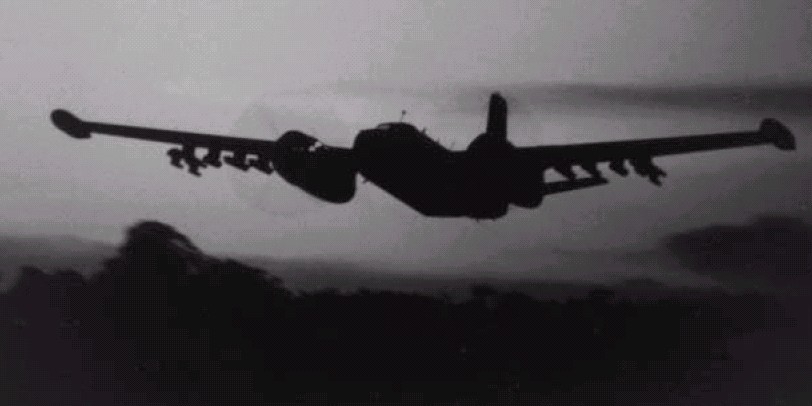Axis & Allies Special Operations Aviation in WW2 and Beyond: False Flags, Agent Drops and Precision Guided Munitions (PGMs) Attacks
By Mike Sparks
The intent of the Nazis can best be summarized by an excerpt from a 1944 French weekly Combat written by General von Stuepnagel in analyzing the causes for German military set backs in WWII:
Thanks to the persistence of researchers and WW2 buffs around the world, serious investigators are now putting together a disturbing picture of WW2 reality not found in the typical, narrow point-of-view, individual Soldier nostalgia tales where they lived it up before facing death and came home to create the "baby boom". Once all aspects are assembled together at least with some representative fragments of truth, they can be connected to paint the full picture of what actually took place. We don't have to wait for the 100-year round of Official Secrets Act facts to become available in 2045. Once you take the greatest common denominator (GCD) and assemble it together, the disturbing picture is as follows:
1. Nazi Germany TRIED EXTREMELY HARD to AVOID WW2 with the British and when forced to fight them, win WW2 from 1939-1943, and when they could not; they ESCAPED from 1943-onwards to form the 4th Reich--which exists today. The American Republican Party is run by descendents and still surviving home-grown AmeroNazis who put Hitler into power in the first place--and enabled the 3rd Reichsters to escape.
Nazi Hydra in America
by Glen Yeady
www.combatreform.org/nazihydrainamerica.htm
Quote:
The evidence of Nazi underground network and escape routes emerged as early as 1943 and was extensive by late 1944. The Nazis made good use of their occupation of France in sending carloads of files and secret formulas over the Pyrenees to neutral Spain. Burnet Hershey, the foreign correspondent of the Hearst press first reported of the German escape route through Spain on January 25, 1943. An excerpt of his statement follows.
A year later, on January 17, 1944 Harold Denny, of the Times confirmed the early report in the following dispatch from Madrid.
They are not easy to deal with, for Germany has extensive commercial interests in Spain and many of these agents are here in the plausible guise of executives, technicians and lesser employees of these interests as well as cogs in Germany's vast diplomatic, consular and propaganda machinery.
2. A lot of Nazi Special Operations aviation operations were directed at not just defeating the Allies in war--but to escape the impending capture of Germany
3. Thousands of agents and escaping Nazis were inserted by special operations aviation to fight the Allies and after 1943 to escape the impending loss of Germany.
We will examine and categorize these actions as either FIGHT or SNEAK, or FLIGHT.
False Flag Operations

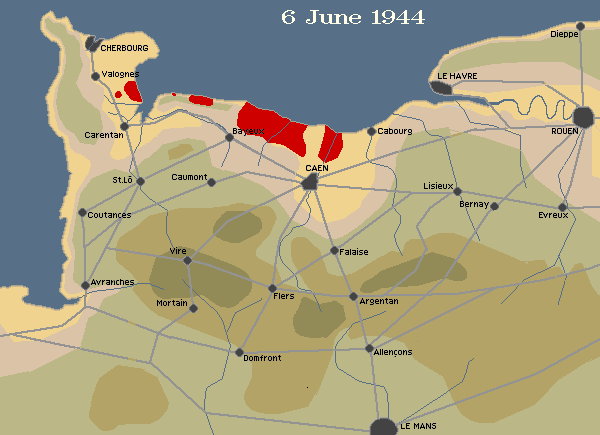
"In the next war, which should take place within 25 years, the same mistake must not be made. The principal adversary will be the United States, and the entire effort must be concentrated against this country from the beginning...Our defeat in the present war need not be considered except as an incident in the triumphal march of Germany towards the conquest of the world, and from now on, we must give a defeated Germany the spirit of a future conqueror. What does a temporary defeat matter if, through the destruction of people and material wealth in enemy countries, we are able to secure a margin of economic and demographic superiority even greater than before 1939? If we can succeed in doing this, this war will have been useful, since it will enable us, within the next 25 years, to wage another war under better conditions...Our enemies will grow weary before we do. We shall have to organize a campaign of pity designed to induce them to send us needed supplies at the earliest possible moment. Above all, we must hold on to the assets we have deposited in neutral countries. The present war will thus have been victorious, in spite of our temporary military defeat, because it will have been a march forward towards our supremacy. We have not to fear conditions of peace analogous to those we have imposed, because our adversaries will always be divided and disunited."41
"Every talk I had with the Germans in Lisbon made that fact clear. They may be defeated on the battlefield, as they were in 1918, but they expect to win again at the peace table as in 1919. Of course, they will sacrifice Hitler as they sacrificed the Kaiser; but the old gang---the generals, big industrialists, phony professors of miss-education about German race superiority---will try to go underground again to lay the eggs for another war of German conquest."42
"Heavy new increments of German agents have been pouring into Spain in recent days in an obvious effort by Germany to save what she can of a situation that has gone badly against her.
A thousand Gestapo agents and other German representatives have appeared in Madrid alone in the past fortnight. Significant additions to the German population have been notes in other parts of Spain.
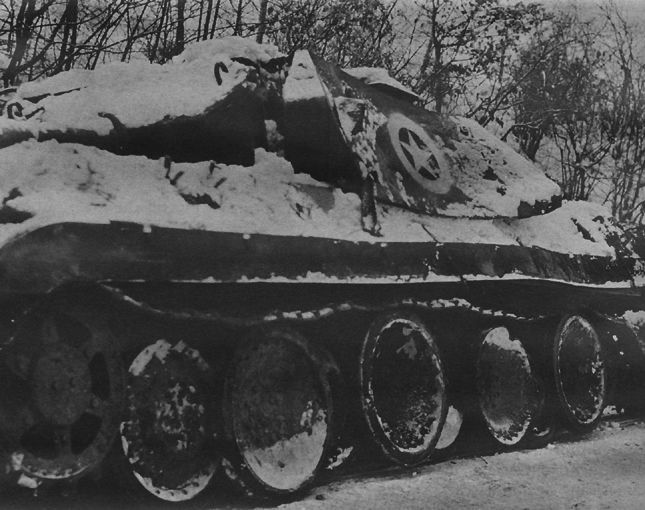
As important as paint camouflage is, it will only work to a point where you get close enough to see the outline of the aircraft, ship or ground vehicle. If you look above, any informed WW2 Soldier or today's armor enthusiast would immediately notice its a GERMAN King Tiger II heavy tank; when we watch movies like Clint Eastwood's WW2 gold heist, Kelly's Heroes we will point out the Tiger tanks in it are not real but modified American tanks made to look like them. During the Battle of the Bulge in 1945, German commando leader Otto Skorzeny had his men dress as American Soldiers and use captured ground vehicles to sow confusion in our ranks to help their main assault. The picture above shows they tried to use their own heavy tanks (we had none) painted in American markings to gain local tactical advantage.
www.combatreform.org/camie.htm
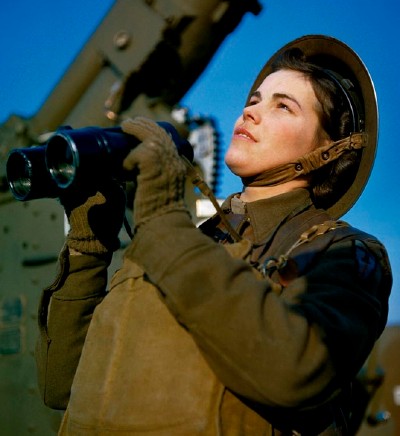
British plane spotters recognize and report enemy aircrafts: A Royal Observer Corps (ROC) plane spotter watches for enemy aircraft. Back in 1925, the ROC was formed to provide a system for detecting, tracking, and reporting aircraft over Britain. Plane spotters learned to recognize aircraft by their silhouette, and often by the sound of their engines. In the U.S., Civil Defense workers and WAACS (Women's Army Auxiliary Corps) maintained spotting stations, and in Germany the Reichsluftschutzbund (National Air Defense League) had a similar mission.
In the sky, distance can aid in avoiding friend or foe detection and has caused many tragic fratricide incidents that continue to the present day. Advanced camouflage techniques like lights to blend in with the daylight skies can extend the non-detection range to even within 1 mile, and chameleonic matching of the background can render defacto invisibility, though the latter seems unavailable during WW2.
Captured enemy vehicles could give one an extra advantage of closer range dismissal by their familiar outline as a "B-17" or "Ju-52". If you can't use an enemy vehicle against them, you can modify a friendly vessel you do have like the HMS Campbeltown which was made to look like a German Moe destroyer in order to ram the dry docks at St. Nazaire packed full of high explosives (HE) in 1942. Painting German markings on a captured American aircraft means if it crashes the crew would not be shot as spies but it certainly insures during daylight that once its outline is not enough to conceal its identity it would be fired upon. Reports are that German markings were kept on for weapons familiarization tours but Allied markings were put back on for clandestine.

Excellent model kit art work; but the Campbeltown's last two stacks were removed and the remaining two sloped to look like a German destroyer! See pics below.
Captured B-17 in German hands
No markings would provide a little more seconds of time and wearing the enemy's markings the maximum cover that in and of itself might enable a flight to proceed without any further challenge especially if its not FIGHTING someone who would challenge it but instead trying to SNEAK to a location.
FIGHT: Wearing a False Flag to Kinetic Energy Attack
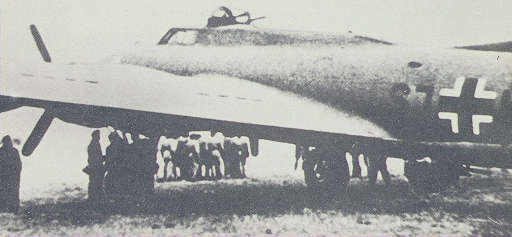
Captured B-17 in German Markings
Light and radio signalman could then buy some more time before the enemy realizes he is being conned by some electronic camouflage--but knowing the daily codes is difficult, and in the case of the St. Nazaire raid, even after the signals stalling failed, all the German guns were opened up on the Campbeltown.
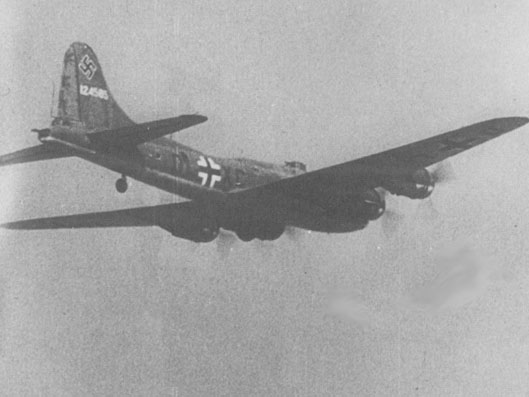
 www.youtube.com/view_play_list?p=A93EC383B70CA686
www.youtube.com/view_play_list?p=A93EC383B70CA686
In the magazine, The Year in Special Operations 2009, Gordon Stevens has an excellent article on the Campbeltown mission; "Operation CHARIOT: The Greatest Commando Raid" proving again that ramming high explosives while wearing a FALSE FLAG is an idea always running in the back of Western military minds:
Given the losses of the [HMS] Hood and destroyer HMS Mashona in the Bismarck engagement, along with almost 1,500 sailors, keeping Tirpitz at bay was a top priority.The wearing of False Flags on large SHIPS dates back to Sea Pirates--a common practice the Royal Navy was well aware of by WW2. In fact, using False Flags on ships did NOT stop with the age of sail and has been used continuously to the present day!British naval thinking on containing Tirpitz was immediate, lateral, and preemptive. If Tirpitz was damaged, the only dry dock she could use remained the Normandie Dock. Remove it, and Tirpitz would have to run the gauntlet of getting back to Germany through the chokepoints that would become the Greenland-Iceland-United Kingdom "gaps." Faced with this, Hitler might not risk trying to use her in the North Atlantic. The Normandie Dock at St. Nazaire was, however, an almost impossible target. The port lay 6 miles up the River Loire, all of it heavily protected, especially the central channel, with its lethal shallows on either side. Still, the need to keep the Tirpitz out of the Atlantic overrode all other considerations.
From May 1941 to January 1942, the British ran through a number of possible options for what became Operation CHARIOT. On Jan. 16, 1942, everything changed when Tirpitz left the Baltic and took position in a fjord near Trondheim, Norway. Bombing missions against her failed, so on Jan. 26, Churchill held an emergency meeting with the First Sea Lord, Admiral of the Fleet Sir Dudley Pound. Within 24 hours, the Combined Operations Directorate and its charismatic chief, Commodore Lord Louis Mountbatten, was tasked with planning and executing CHARIOT.
The CHARIOT plan, delivered in just four days, was simple and audacious. Like a latter-day Trojan horse, a surplus destroyer disguised and packed with delayed-action explosives would ram the gate of the Normandie Dock. Commandos in Motor Launches (MLs) would attack other key installations around the dock area. The MLs would then pick up the destroyer's crew and commandos, and escape to an escort of destroyers waiting out at sea. The Royal Air Force (RAF) would provide a massive bombing raid as cover as the force went in.
The attack force would avoid the German defenses, focused on the main channel of the Loire, by going in across the shallows on a spring (high) tide and on the flood (coming in), going in between midnight and 0200 hours. There was only one short window when all these requirements were met - the end of March, just seven weeks away. For almost a month, the Admiralty refused to provide a destroyer for CHARIOT. Mountbatten retaliated by threatening to cancel the operation, and the Admiralty finally offered the aging HMS Campbeltown (formerly the USS Buchanan, DD 131, loaned to Britain under the Lend-Lease Act). On March 3, the Joint Chiefs gave CHARIOT the green light. In joint command would be Lt. Col. Charles Newman, leading the commando force, and Cmdr. Robert Ryder, running the naval operation. Lt. Cmdr. Stephen Beattie would command a heavily modified Campbeltown. Campbeltown's top weight was lightened to reduce her draft; small-caliber guns were added, steel plating was added to protect the bridge, gunners, and commandos on deck, and 4.25 tons of high explosives were hidden in her bows to prevent a German discovery. To delay the Germans reacting during the approach up the river, two of Campbeltown's four stacks were removed and the other two cut back and sloped, so she resembled a German Type 23 Mowe-class destroyer.
The commando force was divided into three groups, each with its own targets: Group One would land by ML at the Old Mole, Group Two by ML at the Old Entrance, and Group Three would go ashore on Campbeltown. Each commando unit would comprise three parties: an assault team to eliminate immediate opposition, a demolitions team, and a heavily-armed protection team. A key element of CHARIOT was a raid by 350 RAF bombers as a diversion. But just days before the raid, the bomber force was cut back to just 62, and to minimize French civilian casualties, most of their targets would be away from the St. Nazaire docks. Both Newman and Ryder feared that this would alert rather than divert German defences. They were right.
At 1400 hours on March 26, 1942, the MLs slipped out of Falmouth and into the English Channel, followed an hour later by Campbeltown with two destroyers as escort. At 2000 hours the next evening, March 27, the CHARIOT force was 65 miles from St. Nazaire, where Ryder and Newman transferred to MGB 314 to use as their operational headquarters. The escorts slid away, and the force began its run in. Two hours later, at 2200, they saw the navigation light from the submarine HMS Sturgeon blinking the letter "M." They were dead on course and time. The CHARIOT force was laid out in a two-column attack formation: The MLs of Commando Group One were on the port side and those of Group Two to starboard. Newman and Ryder's MGB 314 was ahead and leading. Between the two columns was Campbeltown, carrying Commando Group Three, followed by ML 298 and MTB 74. Along with its modified outline, Campbeltown and the launches flew the German flag, and the signaler on Newman and Ryder's MGB 314 carried captured German codes and signals to delay the response of the German defences.
At 2330, Lt. Nigel Tibbits, in charge of the explosives packed into Campbeltown's bow, activated the time pencils on the charges, while upriver the diversionary bombing raid lit the sky. The flotilla passed the Le Croisic radar station, and by 0045, they had slid undetected under the 75mm gun battery on the Pointe de Gildas. Twice, Campbeltown touched bottom on the shallows but kept going. For precious minutes, their luck held: Then a German patrol boat as well as lookouts at St. Marco spotted the flotilla but, initially at least, their report was ignored. As Newman and Ryder feared, however, the bombing raid raised German suspicions as soon as it began. Between midnight and 0100, the St. Nazaire German defense headquarters issued three warnings of a possible parachute landing or sea assault.
At 0120, as Campeltown passed the Les Morees Tower, the report from St. Marco finally got through. Searchlights suddenly reached across the river, and within seconds, they picked up the gray shape of Campbeltown. But since the Campbeltown resembled a Mowe-class destroyer with a German ensign flying, the German gunners hesitated. Then two batteries fired star shells over the force as a warning, and shore stations flashed challenges at Campbeltown, MGB 314 signaled back, "Wait," with the purloined call sign of a German torpedo boat, then "Urgent... two craft damaged by enemy action. Request permission to proceed to harbor without delay." The German heavy gunners hesitated, then fired again. In reply, MGB 314 signaled, "You are firing on friendly ships." The German gunners hesitated for the last time. As Campbeltown and the light launches entered the mouth of the River Loire itself, German fire raked the river from both sides. Ryder gave the order to return fire; Campbeltown and the launches lowered their German flags and raised the White Ensign.
The game was on.
Do you SEE, Sea Pirates?
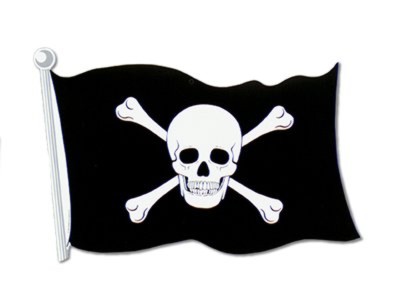
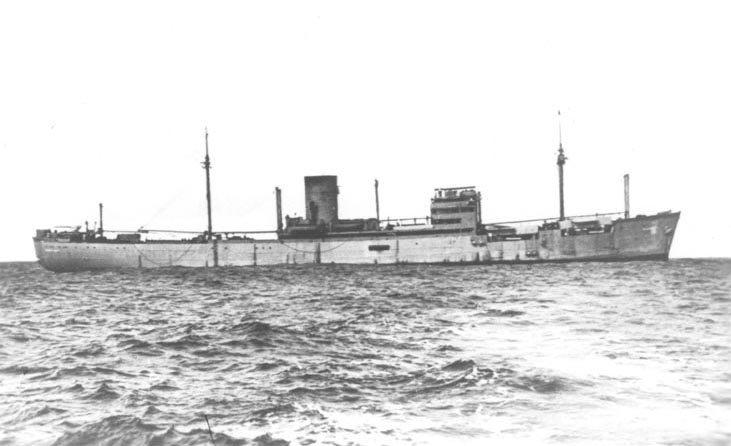
www.combatreform.org/seapirates.htm
When it was a German piloted Allied aircraft trying to sneak in to shoot other planes down with kinetic energy (KE) bullets and small high explosive cannon shells that didn't produce the right radio response it was immediately shot down or forced away. The classic example of this False Flag Cat vs. Mouse game was the dual between an American YB-40 (B-17 gunship) bomber pilot versus an Italian pilot in a captured P-38 fighter. And YES, we had American Nazi traitors like USAAF LT. Martin Monti who stole a P-38 and then did propaganda broadcasts only to receive a slap-on-the-wrist after the war from the pro-Nazi Wall Street run USG with FDR out-of-the-way.
Italian captured P-38 Lightning fighter
www.thedonovan.com/archives/004005.html
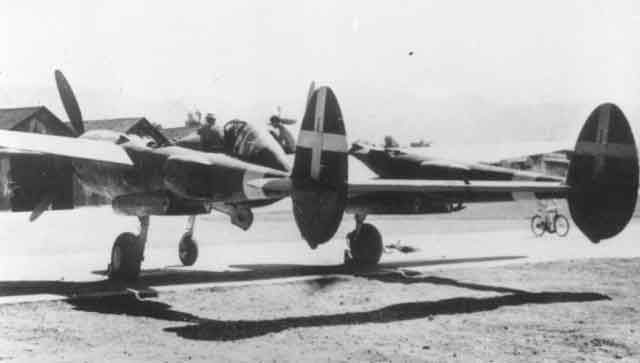
There are many incarnations of the B-17. For instance the prototype YB-40 gunship saw actual combat. It was an attempt at providing long range escort for the bombers. P-38's were having cold weather mechanical problems with their Allison engines, and no other long-range escort craft were forthcoming. Overall the program was considered a failure, but a interesting attempt none the less. They removed the bomb carrying capacity, added a chin and top turrets, dual .50 waist gunners, and armor plating for the crew. Unfortunately it couldn't keep up with the regular 17's after they had dropped their payloads.
One of them was involved in an interesting encounter. It bagged an Italian ace, Guido Rossi. In 1943 a P-38 ran out of fuel and ditched outside Sardinia. The pilot was overwhelmed by locals before he could use his pistol to ignite the tanks and burn the craft. Rossi had the clever idea of using the captured P-38 to kill wounded B-17's returning from bombing missions as stragglers. He bagged several bombers this way. One B-17 Pilot, Lt. Harold Fisher survived an attack, and had trouble convincing others that he was shot down by a 'friendly'.
Fisher was persistent and obtained command of a prototype YB-40 gunship, and flew several missions lagging behind the rest of the bombers trying to lure out the 'Phantom' P-38. As intelligence was gathered in Italy, they discovered Rossi and his captured '38 did indeed exist and had a wife in Constantine. Allies occupied this city, so when the nose art was applied to the YB-40, the artist used a photo of Rossi's wife, and named the gunship after her, 'Gina'.
Fisher flew a mission on August 31st that year, and was actually damaged in the bombing raid, so with two engines out, the YB-40 was even slower, and flew back completely solo. Sure enough, a P-38 approached, one engine feathered, and asked to join up for the trip back in very good English. Fisher almost fell for the same trap again. With the extra firepower of the friendly P-38 along, everything was being unloaded, guns, ammo, armor plate, anything to keep the YB-40 in the air. At this point Rossi came over the radio with an innocent question. "Gina, nice name. Your girl?" Fisher froze and ordered his men to keep their guns, and started baiting Rossi with details of his 'relationship' with Gina of Constantine.
Rossi became enraged, fired up the 'dead' engine, and circled around, intending to fire right through the nose, cockpit and the entire length of the YB-40. The '40 had an innovation that was later added to all B-17's, a chin turret. As Rossi came in, he faced down a total of 8 forward-firing .50's. As the P-38 came apart Rossi even tried to ram the YB-40, but could not maintain flight. He ditched and was picked up by Allied pilot rescue and remained a prisoner for the remainder of the war.
Lt. Harold Fisher received the Distinguished Flying Cross for the encounter, and Major Fisher was killed during a crash in the Berlin Airlift. Former Lt. Guido Rossi attended his funeral out of respect.
SNEAK: Wearing False Flags to Deliver or Recover Agents or VIPs
The classic example in the public consciousness of a false flag camouflaged special operations aircraft is from real-life WW2 Royal Navy combat veteran Alistair MacLean's "Where Eagles Dare" made into a movie starring Clint Eastwood and Richard Burton. A captured German JU-52 "Iron Annie" parachutes the force in and airlands onto an enemy-held airfield to extract them in the middle of a firefight.
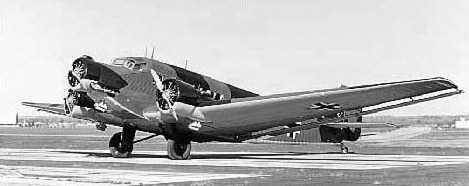
 www.youtube.com/watch?v=8XKGhG0W0LQ
www.youtube.com/watch?v=8XKGhG0W0LQ
Allied WW2 Special Operations Aviation: We Won, So Let's Stay Mum
Let's do a brief survey of primarily American special operations powered delivery aircraft.
Did We ever Wear False Flags on Our Aircraft? How about Vehicles and Soldiers?
Ironically, we know more about German false flag special operations aviation because they ostensibly lost the war and had to resort to "cheating" then we do about our own antics because we "won" and to prop up the fiction that we won "fair & square"--we are silent about our false flag operations in WW2. However we have uncovered some examples. In Nigel West's masterpiece, The Historical Dictionary of Ian Fleming's World of Intelligence, he describes the exploits of Patrick Leigh Fermor, a celebrated Special Operations Executive (SOE) officer in Crete during World War II and the author of The Traveler's Tree, that in Fleming' book Live and Let Die is recommended to James Bond by M as "a chap who knows what he is talking about." M omits to mention that The Traveler's Tree includes a reference to Goldeneye, and its owner, whose guest he had been in Jamaica. Wink.
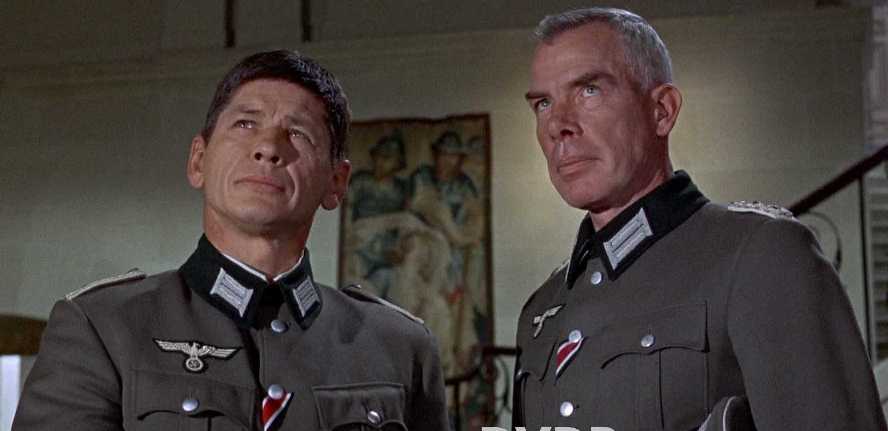
Actual WW2 veterans Charles Bronson and Lee Marvin in The Dirty Dozen
[SOE agents] Moss and Fermor succeeded in stopping German General Kreipe's unescorted Opel sedan outside Heraklion [Crete] on the night of April 26, 1944, while the general was on his way home to his villa at Knossos after an evening of bridge in the German officers' mess at Ano Arkhanais. Dressed as German military policemen, the pair signaled the general's car to stop near a road junction, and climbed in, knocking out the driver. They then drove the limousine into the mountains and spent the next three weeks moving from one hideout to another, evading the numerous German search parties, until May 15 when they were picked up by a motor launch and returned to Mersa Matruh. Despite his unpopularity among his brother officers, Kreipe was promoted to the rank of lieutenant-general the day after his capture. He remained a prisoner of war in Canada until the end of the war. For this extraordinary feat, Moss and Fermor were both awarded the Distinguished Service Order.
In Samuel Katz's book, Soldier-Spies, he notes that Israelis run by SOE had a 45-man "German Platoon" entirely composed of German and Austrian Jews:
Originally the German Platoon was designed as a harassing force to attack German rear columns should they succeed in invading Palestine. When Rommel's advance halted, the German platoon became a first-rate intelligence force, which was the cutting edge of British Special Operations in North Africa and the Mediterranean.
They lived in German uniforms, their secret base looked like a German outpost, living as a German unit they could mingle with German Soldiers and pass un-noticed through enemy lines for the Long Range Desert Group (LRDG). West describes how the LRDG used captured German vehicles in one operation:

In January 1942, he [Fitzroy Maclean] transferred from his regiment to a commando unit designated as L Detachment, and in May he participated in a daring reconnaissance of Benghazi, miles behind the Afrika Korps front line, then occupied by the Italians and Germans. Accompanied by Randolph Churchill and David Stirling, Maclean used his flawless language skills to complete a survey of the port, sabotage the Luftwaffe airfield at Benina, and receive a salute from an intimidated Italian sentry as they left the town. The operation was a success, except that on their journey back to Cairo in a captured German vehicle, Maclean suffered a fractured skull in a collision with a British convoy.
Details:
In January 1942 he transferred from his regiment to a commando unit designated as L Detachment, and in May he participated in a daring reconnaissance of Benghazi, miles behind the Afrika Korps front line, then occupied by the Italians and Germans. Accompanied by Randolph Churchill and David Stirling, Maclean used his flawless language skills to complete a survey of the port, sabotage the Luftwaffe airfield at Benina, and receive a salute from an intimidated Italian sentry as they left the town. The operation was a success, except that on their journey back to Cairo in a captured German vehicle, Maclean suffered a fractured skull in a collision with a British convoy.After three months of hospital treatment, Maclean was back in action in September, playing a leading role in BIGAMY, a daring raid on Benghazi. Maclean was part of the advance party that drove ahead of Stirling's main force, consisting of nearly 300 volunteers in 95 vehicles, including 43-tonners, through the minefields of the Libyan desert to make contact with a Secret Intelligence Service (SIS) agent who had been living for weeks in caves outside Benghazi, reporting on enemy troop movements. The scruffy, bearded figure who attended the rendezvous with Maclean turned out to be Bob Melot, a 50-year-old Belgian who had been a fighter ace in World War I and then had worked as a cotton trader in Alexandria. Fluent in Arabic, his local contact was another equally improbable SIS agent, Professor Alan Lyle-Smythe of Cairo University. Having received the latest information on the local enemy forces, Maclean made contact with Stirling's force and the attack, against an overwhelming enemy force, was launched in coordination with an air raid conducted by the Royal Air Force.
BIGAMY proved a disaster. During the withdrawal and the three-day drive back to Kufra, the Luftwaffe picked off nearly 70 of the vehicles as they attempted to hide in the barren terrain. Nevertheless, despite the appalling casualties for no obvious gain, the survivors were reformed as the 1st Special Air Service, a regiment commanded by Stirling, then aged 27, until he was captured four months later in Tunisia in January 1943.
Promoted to lieutenant colonel, Maclean was selected to lead a British military mission to Yugoslavia in September 1943 to make contact with the leader of the Communist resistance, a partisan known by the nom de guerre Tito, who was believed by British Intelligence to be a woman. Winston Churchill had been impressed by Maclean when they had talked in Cairo, even if he had accused the Scot previously of having used the House of Commons "as a public convenience" to escape the Foreign Office and enlist in the army. Now Churchill appointed Maclean his personal representative, and he proved a tremendous success with Josip Broz, alias Tito, who would become his lifelong friend. Maclean's organization boasted an astonishing elite of the British military establishment, complete with experienced SAS officers, expert sappers and commandos, separate lines of communications, and a network of sub-missions spread across the country. Maclean's staff had direct access to the very highest levels in Cairo and London and also included, at one moment in 1944, Evelyn Waugh and Randolph Churchill.
Note that Waugh's semi-autobiographical Sword of Honor was made into a mini-series starring the pre-James Bond, Daniel Craig.
At the end of WW2 German commando leader Otto Skorzeny was on trial for his life accused of wearing Allied uniforms and committing atrocities like the Malmedy massacre during the 1944 Battle of the Bulge. His life was saved when SOE operative, RAF wing commander Forrest Yeo-Thomas came in to testify that Allied forces had often worn enemy uniforms on operations like Skorzeny's Brandenbergers. In Skorzeny by Charles Whiting, on pages 143-146 he elaborates:
For two days he explained his plans and their execution during the battle, he did not deny that he and his men had been prepared to wear and had actually worn American uniforms during the course of his operations. His defence of his actions was that he had not been alone in doing this; before him virtually every other Allied nation had used the same dodge. In the case of the Americans they had worn German uniforms on several occasions, for instance during the attack on Aachen; and it was this occasion which had given Hitler the idea of having Skorzeny's men wear American uniform.During the course of this two-day marathon in the witness box, Colonel Durst raised the question of the alleged plot to murder General Eisenhower. Immediately the President of the Court ruled Colonel Durst out of order and the question struck from the rolls. Thus the Eisenhower plot was never satisfactorily explained and that particular canaxd4was to stay with Skorzeny for ever (being brought up time and time again in the years to follow).
At the end of the two days Colonel Durst and Otto Skorzeny had conjured up the picture of a new type of warfare which in the ever changing technological 20th century was always ahead of the laws intended for the more sedate 19th century. In other words the Hague - Conventions for land warfare drawn up in the first decade of our century and based on the experiences of the previous one had simply no relevance to our own time with its atomic weapons, area and strategic bombing, and, naturally, its various types of irregular warfare. To solidify his case, Colonel Durst called a surprise witness, Wing-Commander Forrest Yeo-Thomas.
Skorzeny had already read about the legendary Yeo-Thomas, the "White Rabbit" as he had been called in French Resistance. circles, in Korgon's SS Start, but thought that he had been killed in the war. Now the short sturdy figure in RAF blue appeared to be very much alive, in spite of his long years in the Resistance and the hard slog in Whitehall trying to convince Churchill and others of the need to support the new French underground movement. In the end he had been captured, taken to Buchenwald from where he had escaped, leaving a corpse in his place, and walked to the Allied lines. Immediately after the war he had given evidence at the Buchenwald war crimes trial which had resulted in twenty-two of his guards being sentenced to death.
Skorzeny must have wondered whether this was the right man to give evidence for him. There seemed to be no reason why he should show any favour to his former enemies who had treated him so badly during his period of captivity.
But Skorzeny, like the rest of the court, was in for a surprise. Without hesitation, and fully aware of the meaning of his testimony for Skorzeny, he told the court:
"My comrade was in prison at Rennes in Brittany. I reconnoitered the jail and bribed one of the guards to find out when rounds were made and the general procedure . ... Then I put some of my men who spoke German into German uniform and secured copies of German papers required to take a prisoner out of jail. We stole a German car and I also had a van rigged up to resemble a prison van. The plan was to ring for the gatekeeper and show him false papers. We would drive in with the German car and then bring the van in and stall it so that they could not close the gate."
Durst let him explain the raid in full detail, waiting for the moment when he could make his own point.
"The men in German uniform, one of them disguised as an officer, were to go into the guardroom. If the prisoner were not delivered to us on sight of the papers, if there were any hesitation, we would dispose of the guards quickly and silently."
He paused and Colonel Durst asked: "Did you obtain German uniforms for this purpose?"
"Yes".
"How were they obtained?"
"The details I could not tell you. I gave instructions to obtain uniforms by hook or by crook."
Durst then led him up to stating, after being asked whether he and his men were armed when they wore German uniforms, what they did.. "To prevent danger of discovery, what would the practice be?" Durst asked.
Wing-Commander Yeo-Thomas now glanced around the court before replying: He said softly: "Bump off the other guy."
Colonel Rosenfeld's case had vanished. As Yeo-Thomas came down from the witness stand, Skorzeny and the other defendants in the case got up from the cage and stood silently and stiffly to attention; it was the only token of respect and thanks they were in a position to offer to the former enemy who had saved them, though later Skorzeny sent him a note of thanks, to which Yeo-Thomas, now director of Molyneux, the Paris dressmaker, replied: "You did a damned good war job. I'm sure you will get off. In any case I have a flat in Paris if you should need somewhere to lie up."
A few hours after Yeo-Thomas's evidence, the case against Skorzeny was dismissed, but in spite of being acquitted, he was still not released. He was transferred to a "denazification" camp at Darmstadt. Every time his case came up for review it was postponed for some reason or other. The months passed. When his case was postponed for the seventh time Skorzeny had had enough. Writing to Yeo-Thomas he asked him for his advice. The reply was laconic and to the point: "Escape", he wrote back.
On 27th July 1948 Otto Skorzeny did exactly that. Stowing away in the luggage compartment of a car he left the camp with Radl's aid. The car drove to a spot ten miles from Darmstadt where a suitcase with clothes was waiting for him. He changed in a wood, then took a train to Stuttgart. The next day he traveled to Berchtesgaden, where he hid out and waited to see what the authorities' reaction would be. It was passive. Unofficially he was told by the German authorities to keep out of sight. They were not interested in him. West Germany was in the process of becoming a sovereign state once more and they did not want any trouble with the Allies, so he was to keep himself to himself.
Office of Strategic Service 1942-45: The World War II Origins of the CIA by Eugene Liptak on page 36 shows how the creator of U.S. Army Special Forces (Green Berets) Colonel Aaron Bank was a Jedburgh team leader in WW2 and assembled a team of assassins to raid Hitler's underground base while wearing GERMAN ARMY UNIFORMS. Disregard the caption's establishment non-sense that Hitler never left Berlin etc. The author met the late Colonel Bank at a banquet at Fort Bragg in 1992 and discussed the current narcissistic-incompetent state of Army SF and things like bicycles which he used in France for discreet mobility.
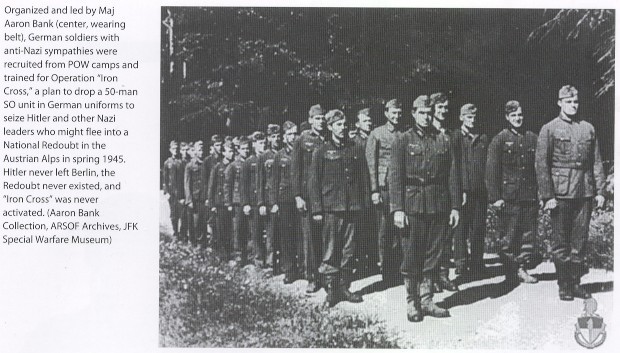
New Zealand historian Greg Hallett in his masterpiece, Hitler was a British Agent (HWABA) that the British had a captured German Fw-2000 Condor aircraft for clandestine agent insertion/extractions--the same long-range maritime patrol plane Ian Fleming wrote about after the war in his James Bond 007 novel, Thunderball.
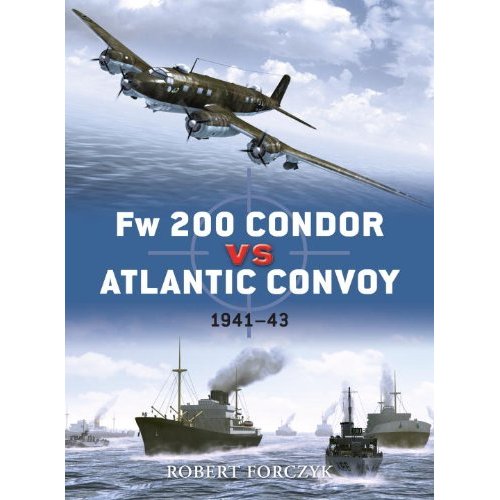
Retired former armor branch U.S. Army Colonel Robert Forczyk writes in his excellent book, Fw-200 Condor vs. Atlantic Convoy on page 28 of how the British used false cargo ships to hide anti-aircraft guns and considered using a Fw-200 painted to look like a Condor in a commando raid:
On the other side of the Channel, the Admiralty initially responded to the Condor threat with a variety of ad hoc measures. As a quick fix, the 5,000-ton freighter HMS Crispin was converted into a disguised anti-aircraft vessel, armed with a 100mm (4in) high-angle AA gun and six of the new 20mm Oerlikon guns. Crispin would pretend to be a merchant vessel trailing behind a convoy, in the hope of attracting a low-level attack. However, after several months of dull escort duty without sighting a Condor, it was sunk by a U-boat on February 3, 1941. Given that the Q-ship had to follow alone behind the convoy in order to attract air attacks, it lacked survivability in U-boat patrolled waters and the Admiralty decided not to sacrifice any more crews in this role.Churchill pressed the Admiralty to improve convoy anti-air defenses as rapidly as possible, but these emergency measures would take months to implement. In the interim, Churchill suggested a Commando raid against KG 40's airbase at Bordeaux using a single Danish-owned civilian Fw-200 in a "Trojan horse" operation. The plan called for the aircraft, repainted in Luftwaffe colors, to land at Bordeaux at night. The two dozen troops on board would then disembark and destroy every Condor on the base. Although such a raid might have severely disrupted KG 40's operations for a while, there was no viable extraction plan for the raiding force, so the Commandos sensibly backed off from an obvious suicide mission.
In November 1940, Britain's only real offensive tool was RAF Bomber Command and Churchill redirected it squarely at the Fw-200 threat by ordering raids against Bordeaux-Merignac airfield and the Focke-Wulf plant in Bremen. The first raid on Bordeaux-Merignac took place on the night of November 22-23, 1940, and saw 32 bombers destroy four hangars and 2 Fw-200s on the ground. Three follow-up raids were unsuccessful and it was not until the raid on April 13, 1941, that three more Condors were destroyed at the base. Bomber Command continued to raid the airfield on occasion, but Luftwaffe anti-aircraft defenses improved to the point that no more Condors were destroyed on the ground. Given that Bomber Command's aircraft had little ability to hit point targets at night and were generally missing their aim points by about 3km (2 miles) or more in 1940-41, the fact that 191 sorties on Bordeaux-Merignac destroyed 5 Condors on the ground is remarkable. The first major raid against the Focke-Wulf plant did not occur until January 1, 1941, and although it caused some minor disruption in Condor production, it only encouraged the company to shift much of the Fw-200 production inland to Cottbus. Despite the inability of the British to intercept Fw-200s over water or destroy their bases and factories, the duel between the Condors and the British Atlantic convoys was on.
Notice his anti-special operations, armor-branch bias showing and that unguided high explosives bombing from medium altitudes was ineffective--a subject we shall soon cover.
He-111s towing Gotha 242 assault gliders
One Allied aircraft false flag operation we know was planned was Royal Naval Intelligence Division 17 Commander Ian Fleming's Operation RUTHLESS slated for late 1940 where British crews were to fly a captured German He-111 bomber along with a returning bomber attack and pretend to lose an engine over the English channel to lure a German Navy vessel to come rescue them. Once on board, they'd draw their concealed weapons and take-over the vessel and speed it back to England with the difficult to crack Kriegsmarine naval code 3-rotor cipher machine. The operation was said to have been cancelled due to timing difficulties to coincide with a German air raid.
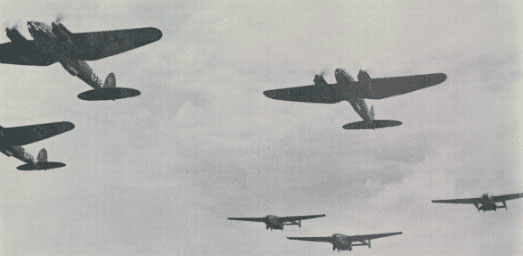
 www.youtube.com/watch?v=WBcDZEUxyM0
www.youtube.com/watch?v=WBcDZEUxyM0
Allied Long-Range Insertion/Extraction of Allied Agents
The marriage of bombers and transports that can carry large loads for long distances with special operations missions is a natural one but with two drawbacks. Transport planes have large fuselages to carry large loads but this creates drag and the plane doesn't fly as fast or with agility like a thinner bomber. Adding to this vulnerability is a lack of armor and armament. The problem with a bomber is finding enough volume for men/equipment in an aircraft carrying compact high explosive bombs.
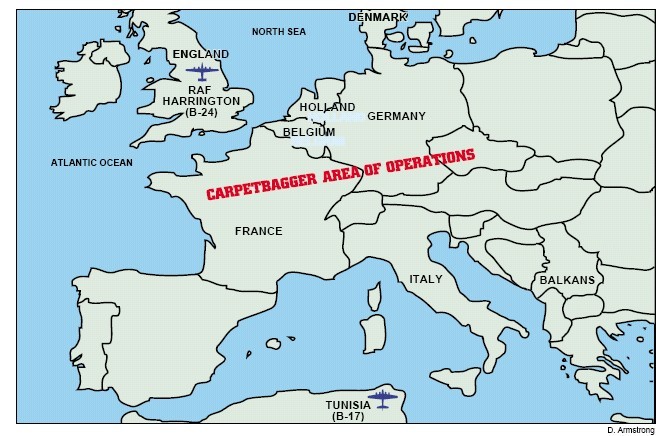
Aircraft that would not have built-in fuselages but instead LTG Gavin's "KIWI" pods described in his 1947 book, Airborne Warfare would be the ideal answer--but to date only the XC-120 prototype from the early 1950s and the S-64/CH-54 Skycrane helicopter have exploited this. Thus, yet another of LTG Gavin's visions that have yet to be fully acted on.
www.combatreform.org/aircraftphotos.htm
Thus, the DC-3/C-47 Dakota transport plane was the primary agent insertion/extraction plane for the Allies in WW2, Korea and Vietnam though it lacked speed, armor and most cases armament. Since it didn't have a large opening, large items like 75mm pack howitzers were dropped in pieces via under-slung bundles tethered cleverly together--but its left side jump door was big enough for Paratroopers to exit holding a folding bicycle.
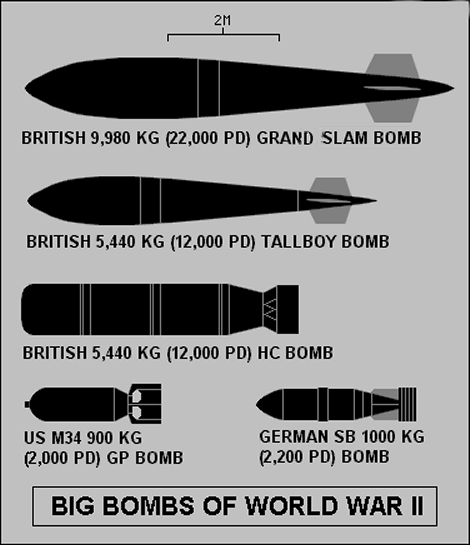
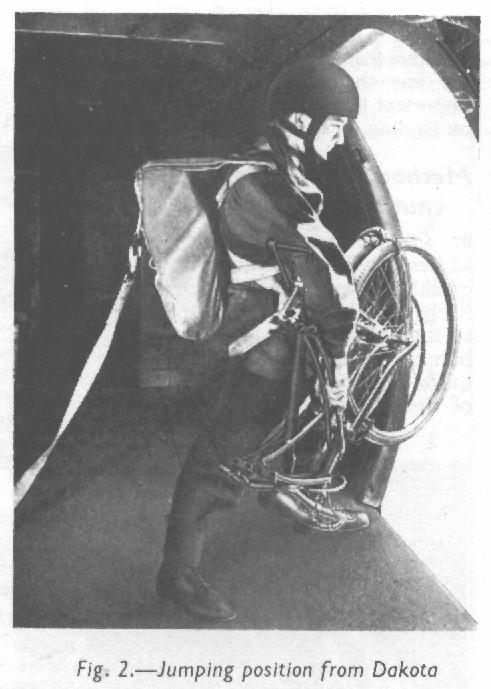
Military Airborne/Special Operations Vehicles
Allied Paratroopers were thus able to jump with complete combat weaponry/equipment--a capability the German fallschirmjaegers couldn't do through the tiny JU-52 left jump door--which had fatal consequences on Crete in 1941. A tail-dragger, it could land and take-off from short fields and its speed can be somewhat improved by more powerful engines. What cannot be easily fixed is the slanted cabin floor that requires uphill loading. Today's Basler Turboprop DC-3s have a winch in the front of the floor to pull loads up. The German's planned replacement for the JU-52, the JU-352 had a clever solution: a rear loading ramp that when lowers RAISES the tail and levels the aircraft floor.
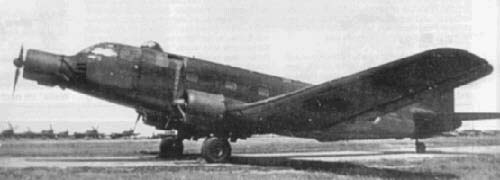
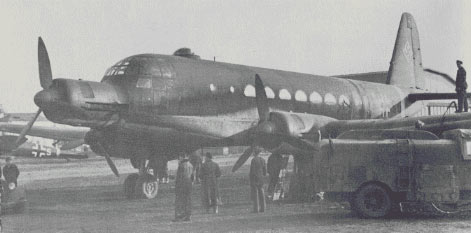
The JU-352 preserved its tail-dragging STOL capabilities while solving the uneven loading problem with its rear ramp that lifted the tail and leveled the floor
Deep Penetration Dangers: Must Fight Their Way In & Out
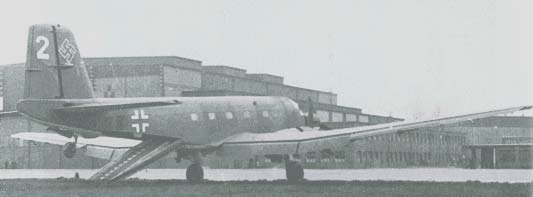
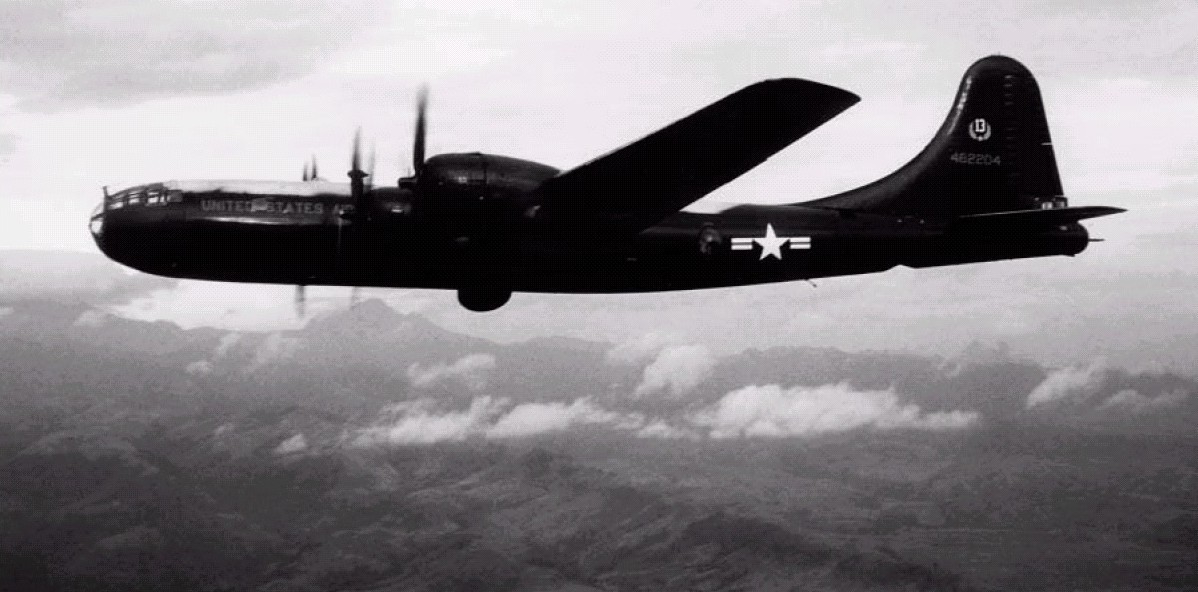
Despite some modest progress in air delivery using 200 mph transport planes, they were still slow, unarmed and getting shot down in horrendous numbers. Bombers with machine guns for self-defense, armor and at least 300 mph speeds were modified to drop agents, supply bundles through holes cut in the fuselage bottom "Joe Holes") and even jeeps with Anti-Tank (AT) guns through the bomb bays!

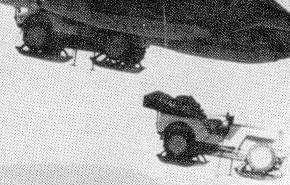
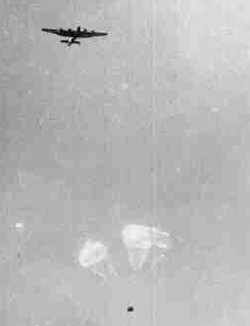
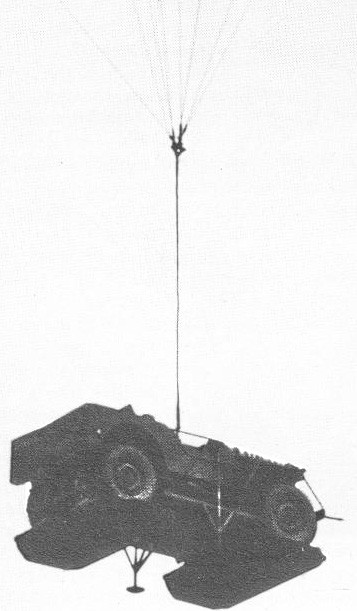
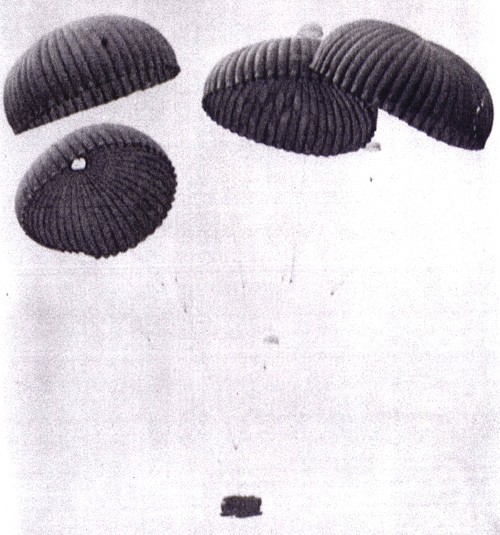
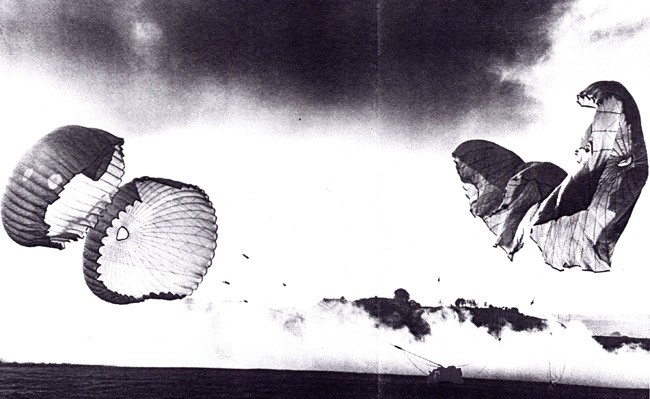
Details:
To get faster agent delivery means during WW2, we figured out how to drop OSS agents from the bomb bays of A/B-26 Invaders into Europe. Office of Strategic Service 1942-45: The World War II Origins of the CIA by Eugene Liptak on page 61 states:
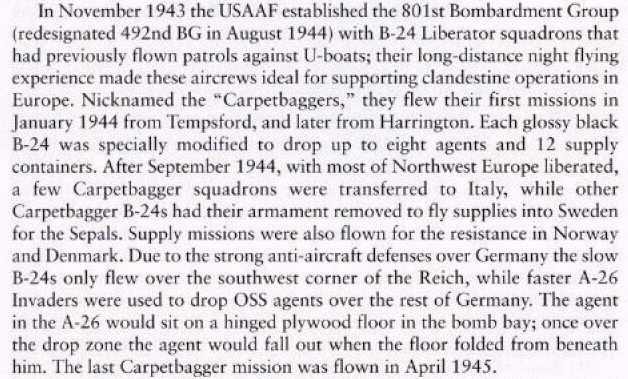
This practice was continued later on in Korea and explains why the CIA loved the A/B-26 bomber so much that it was the star of the ill-fated "Operation ZAPATA" Bay of Pigs invasion of Cuba in 1961. The glass-nosed A/B-26s were used so the bombardier/navigator could find the drop zones for the 6 men in the bomb bay--however these models were NOT the solid-nosed types bristling with .50 caliber heavy machine guns favored by CIA aviators but in use by Castro's air force. Why the CIA failed to conjure up at least one glass-nosed A/B-26 for its phony defector who flew to Florida cover story unhinged the whole credibility of the operation--which may have been the goal all along: force President Kennedy to send in the U.S. military to salvage a failing CIA op or to embarrass and ruin him. Maybe both?
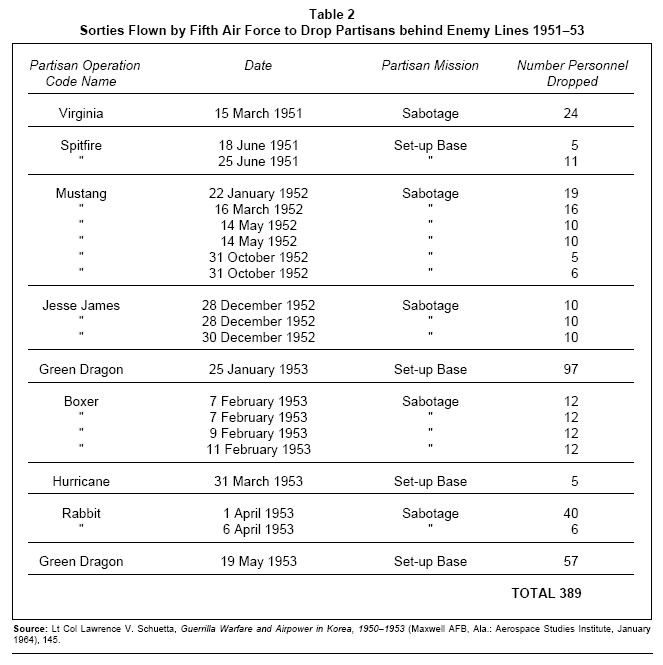
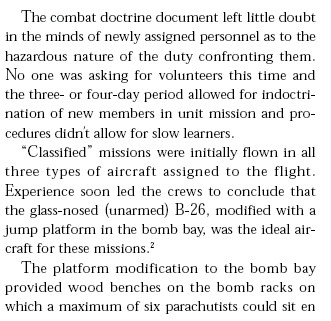
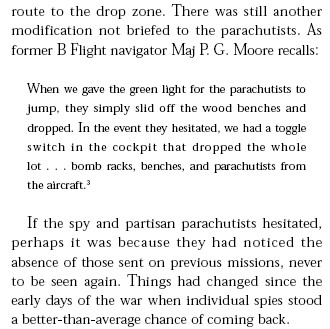
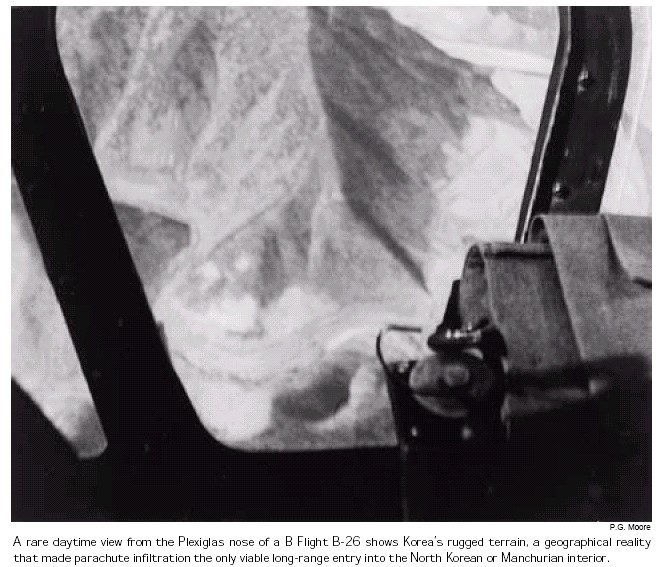
We also used Joe Holes and the bomb bays of giant B-29 Super Fortress heavy bombers to be ready to infiltrate guerrillas deep into the Soviet Union.
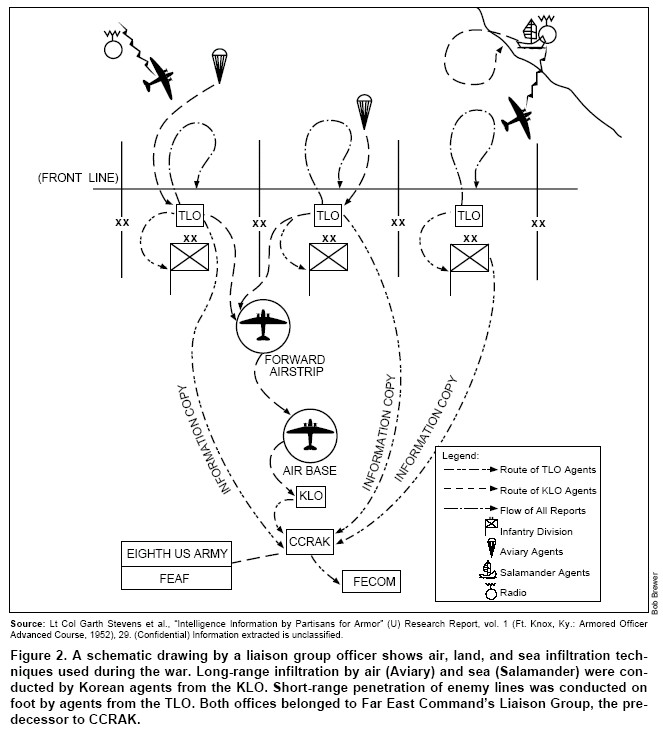
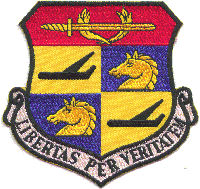

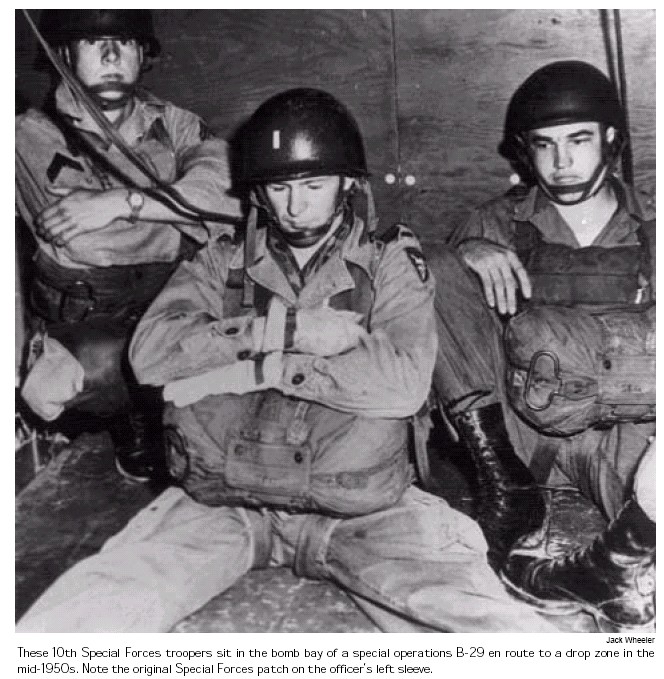
Suggested Reading:
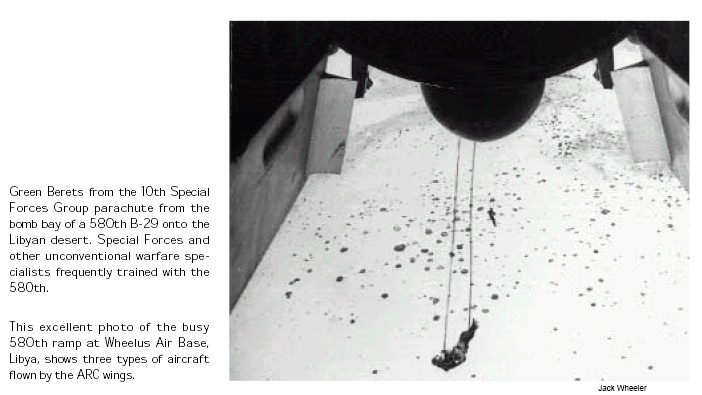
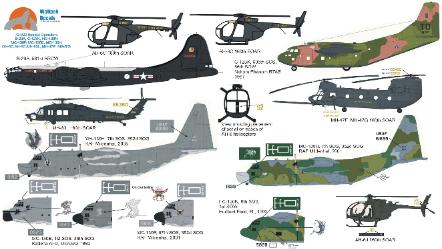
Praetorian Starships
by Colonel Larry Thigpen
www.combatreform.org/thigpen.pdf
Apollo's Warriors: United States Air Force Special Operations During the Cold War
by Colonel Michael Haas
http://aupress.maxwell.af.mil/Books/Haas/Haas.pdf
www.combatreform.org/haas.pdf
French Resistance Jedburgh Teams and Jeep Drops
www.combatreform.org/paratrooper.htm
www.combatreform.org/groundvehiclephotos.htm
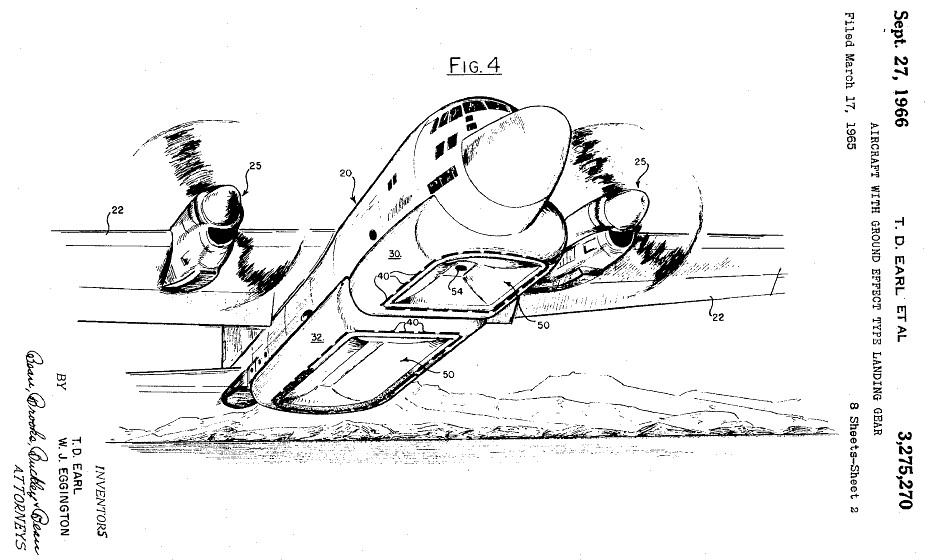
Future Air Commandos: Colonel Phil Cochrane & Brigadier General "Heinie" Aderholdt's Vision for Today
www.combatreform.org/AIRBORNEMUSEUM/nlmb.htm
Germans Escape--Sometimes using Allied Planes--and Markings

Germans dressed as American aircrews by captured B-24
To insert/extract agents or help Nazis escape to other countries, a captured Allied plane at night would have enough camouflage with its outline to deceive for its safe passage.
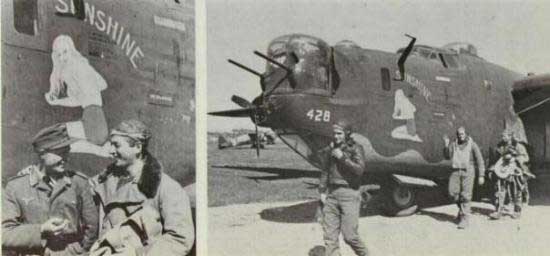
KG 200 "stork delivering" insignia clad captured American B-17
The question that has to be asked is how much FIGHT could be achieved dropping agents into France provide weeks after the Allies had just landed there? It seems these were more likely to be Nazis fleeing to set-up rat-lines for others to follow and start up the 4th Reich in Spain, South America and Antarctica.
SNEAK: German Aircraft, German Markings, German Agents
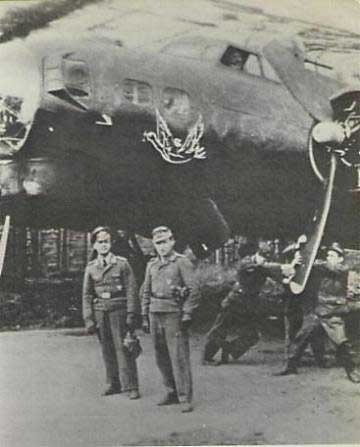
4-engined JU-290
Long-Range Aircraft
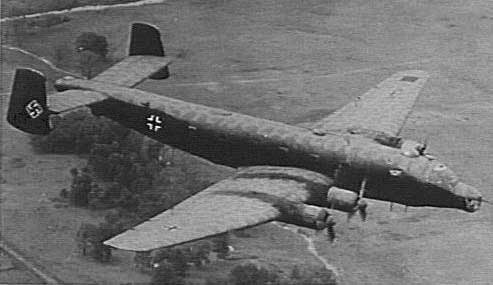
The ultra long-range JU-290s and -390 transport/bombers that KG 200 had that could fly all the way to America to drop a nuclear bomb or all the way to South America or Japan were likely used to move Nazis and their loot to jump-start the 4th Reich.
Reich of the Black Sun
by Dr. Joseph P. Farrell
www.combatreform.org/black_sun.htm
6-engined JU-390
Other delivery aircraft to get Nazis to South America?
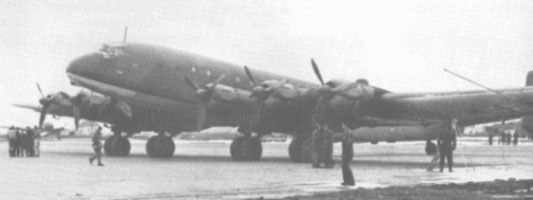
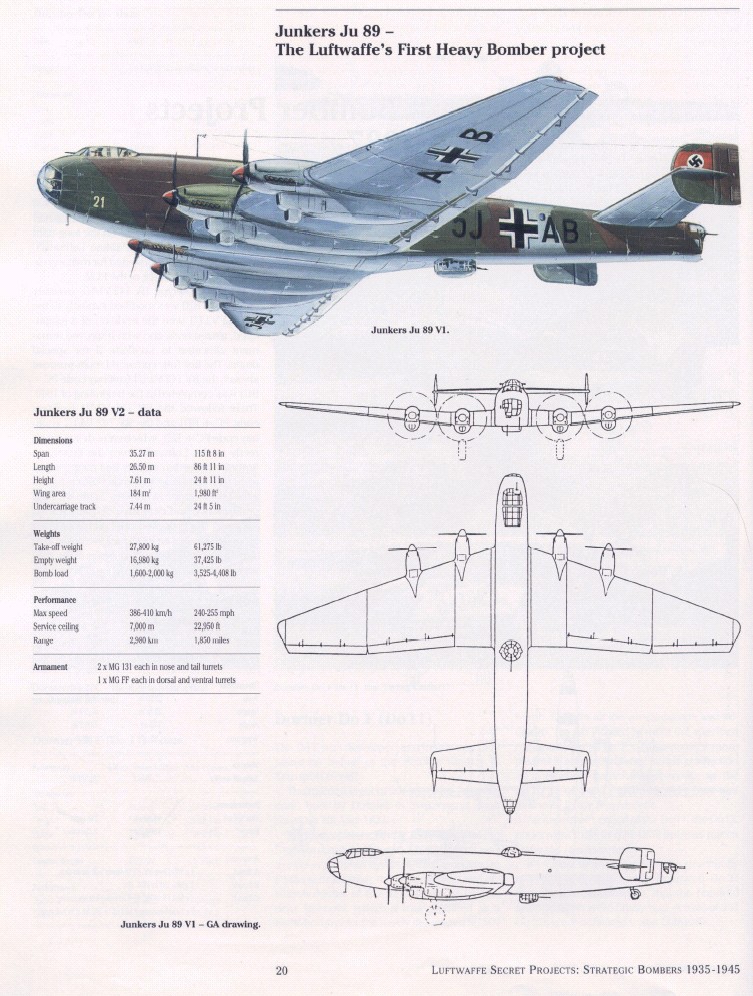
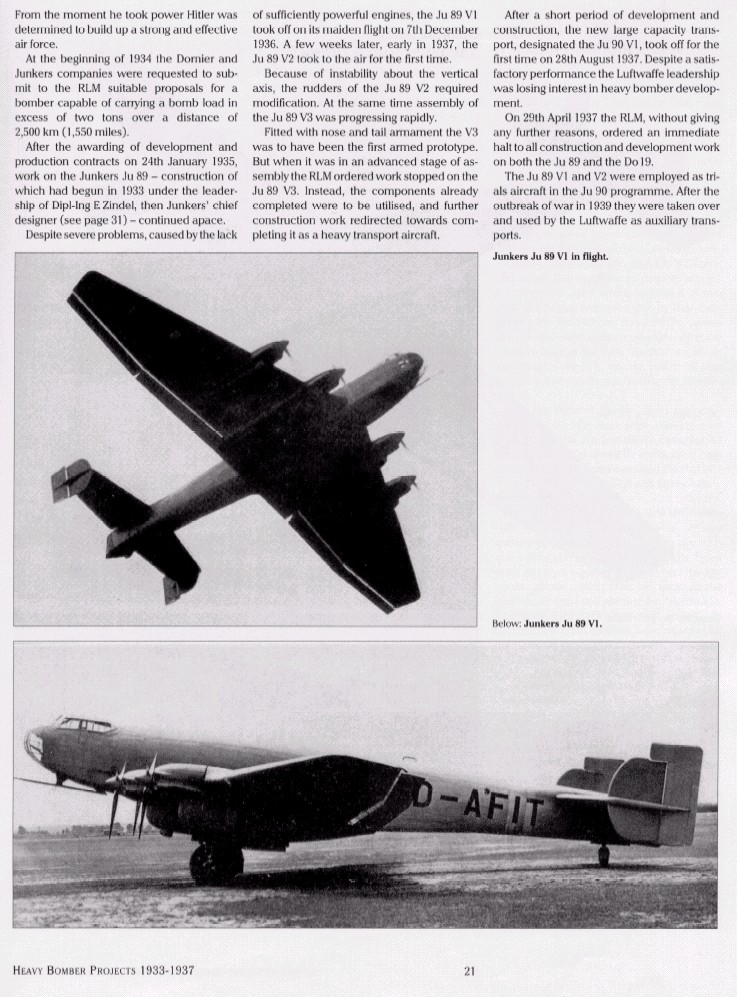
Drop Pods
Special Escape, Insertion/Extraction means
KG200: The True Story by P.W. Stahl indicates that these PAGs (as they were called - see below) were indeed used operationally:
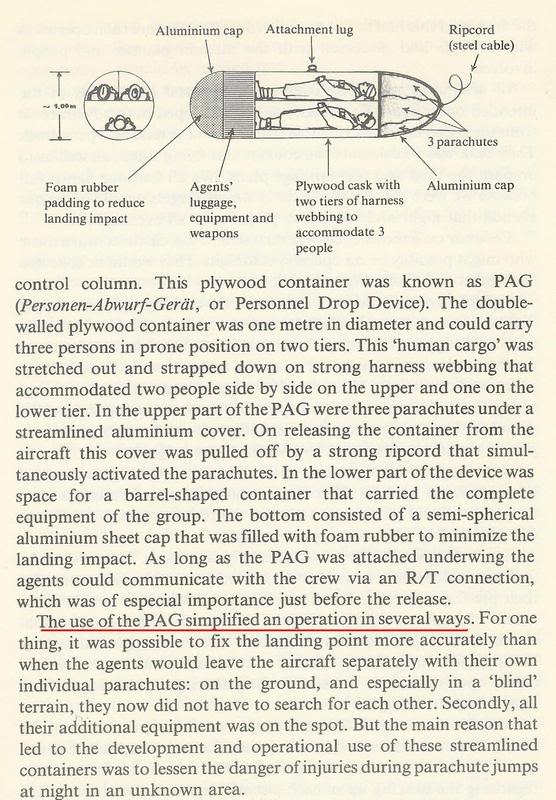
Notice the extremely exotic "people pods" and automatic opening parachutes: these indicate crutches for UNTRAINED Nazis to deploy from aircraft--not paratroopers meant to FIGHT the war in some way. However, it indicates an extreme interest LATE IN WW2 to infiltrate Nazis OUT OF EUROPE...WHERE were they going?
http://greyfalcon.us/KG%20200.htm
Detachment Olga was responsible for landing agents in France, which was under Allied control. The KG 200 pilots usually dropped agents by parachute, but on some flights they would drop a personnel drop device--a metal and plywood container holding three agents and their equipment that would parachute to earth. The KG 200 pilots made supply runs to keep their covert activities in operation.
He-115: a seaplane
http://en.wikipedia.org/wiki/Heinkel_He_115
The first group of KG 200, I./KG 200, flew a total of 3-4 He 115's and were responsible of dropping Abwehr agents behind enemy lines. The largest number of agents dropped by I./KG 200 was in July 1944, where a total of 260 men and women were dropped, mainly using automatic parachutes. The total number of agents dropped between June 1944 to March 1945 were 600. Out of these, 5-10 were women.
STOL Gliders and Transports
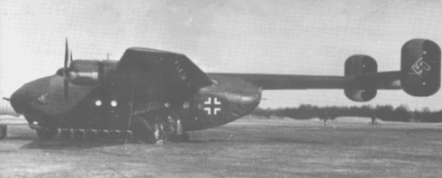
Another German innovation was the assault glider with multiple small wheels for low ground pressures, rear cargo ramp and powered versions to take-off and land nearly anywhere. The assault glider that can land in cow pastures is a military tool we have lost as lamented by LTG James Gavin in his masterpiece, Airborne Warfare:
Airborne Warfare
by LTG James M. Gavin
www.combatreform.org/airbornewarfare.htm
It seems very clear that German special operations aviation had a FIGHT mission from 1939-1943 that gave way to a FLIGHT mission from the loss of the Battle of Stalingrad from 1943-1945. One of the ways to attain long ranges is by using SEAPLANES that can land on the water to interface with surface ships/submarines (U-boats) to get agents in or Nazi war criminals out. From 1939-1941 flights to Ireland to concoct an Irish rebellion were undertaken using the He-115 seaplane with some agents using folding bicycles to move around the countryside afterwards.
www.combatreform.org/militaryvehicles.htm
The Allies used seaplanes for special operations throughout the war; the most famous mission was the 1942 HMS Seraph submarine delivery of U.S. Army General Mark Clark by small boat to confer with North African Vichy French leaders sympathetic to our cause, followed by seaplane pick-up back to headquarters.
http://books.google.com/books?id=LVEEAAAAMBAJ&pg=PA75&lpg=PA75&dq=general+clark+submarine&source=bl&ots=xM8R2PpTXM&sig=AQvomvfwn8whDyVucAG78sFeyts&hl=en&ei=4x8yTKz6DYT7lwfCpsW-Cw&sa=X&oi=book_result&ct=result&resnum=2&ved=0CAoQ6AEwAQ
From Office of Strategic Service 1942-45: The World War II Origins of the CIA by Eugene Liptak, page 61:


However, what were the German seaplanes doing from 1943 onward when it was clear the war was lost? You don't hear much FIGHT history of them, indicating they were used for FLIGHT to get the Nazis and their loot stolen from the teeth of their concentration camp victims overseas in hidden locations.
Seaplanes for Quick-Getaways from Land to Link-Up with Naval Vessels
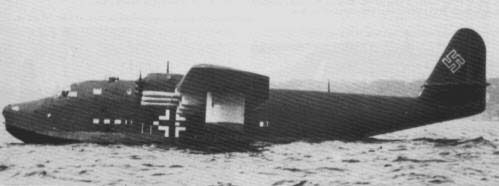
6-engined BV-222 long-range seaplane
Seaplanes could also refuel from surface ships or U-boats to further range, but it seems that their primary purpose would be the quick getaway from land perhaps by the many German lakes as Greg Hallett documents Commander Fleming did to get Hitler/Eva Braun to Spain in HWABA. Once out of the grips of the Allied land armies converging from west and east, Nazis could fly by seaplane along the northern route over German-occupied Denmark to Norway to land on the water and transfer people and cargo to an U-boat waiting at a rendezvous map coordinate for them. Farrell in Nazi International mentions the inexplicable waiting by an U-boat off the coast of Norway as a possible Nazi party secretary Martin Bormann escape scenario. The most militarily logical explanation for the U-boat lingering was for it to link-up with a seaplane.
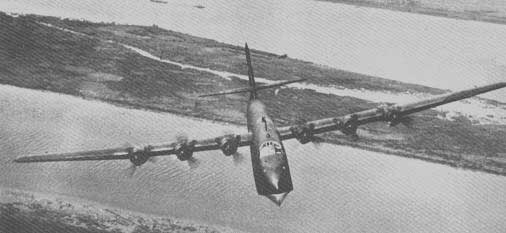
Small Bv-138 seaplane
Small seaplanes were launched and recovered from all sorts of ships--to include the German raiders that wore false flags. That one needs a bloated aircraft carrier to get air power at sea is a LIE of the aircraft carrier bureaucracy.
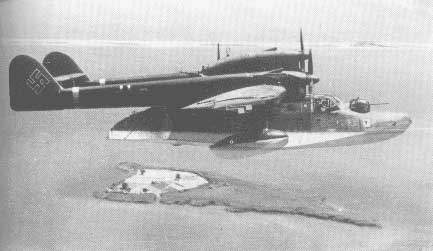
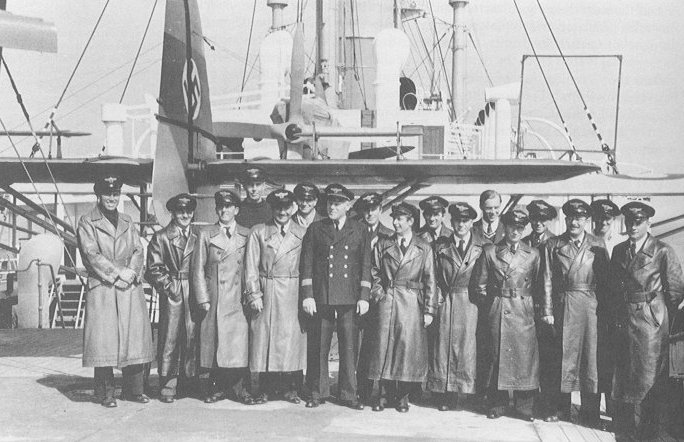
One of the most mysterious and suspicious uses of catapult-launched seaplanes was the Nazi expedition to Antarctica where a new German homeland was claimed that no doubt was where some of the 4th Reichsters ended up after the war. As operational leader of British naval Intelligence, Commander Ian Fleming was fully informed of the German Navy's activities to get Nazis out of Germany to start the 4th Reich.
Greg Hallett has documented in HWABA describes in detail, the most epic and clever use of a seaplane and short-take-off and landing (STOL) aircraft for a JOINT Axis-Allied (yes, you read that right!) special operation to date: the JU-52 floatplane rescue of Adolf Hitler and Eva Braun!
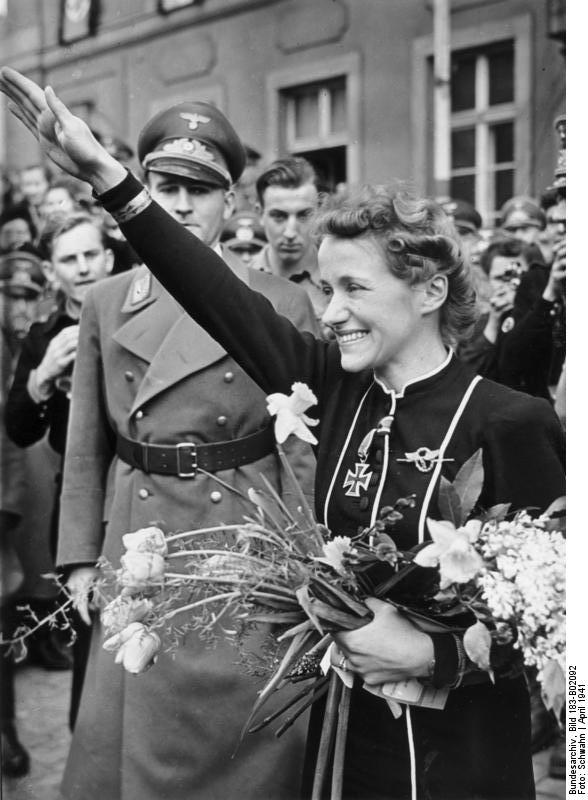

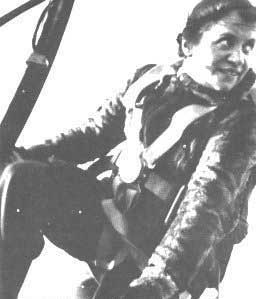
The mission was flown by Hitler's favorite and best pilot: A WOMAN. That's right, a WOMAN was the 3rd Reich's best pilot. The ubersexy and legendary pilot Hannah Reitsch flew a JU-52 seaplane to rendezvous with a mini-submarine holding Hitler and his wife, both waiting for her under Lake Muggelsee near Berlin.
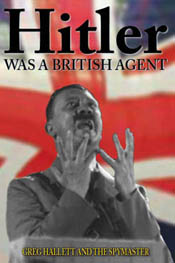
Hitler was a British Agent (HWABA)
by Greg Hallett
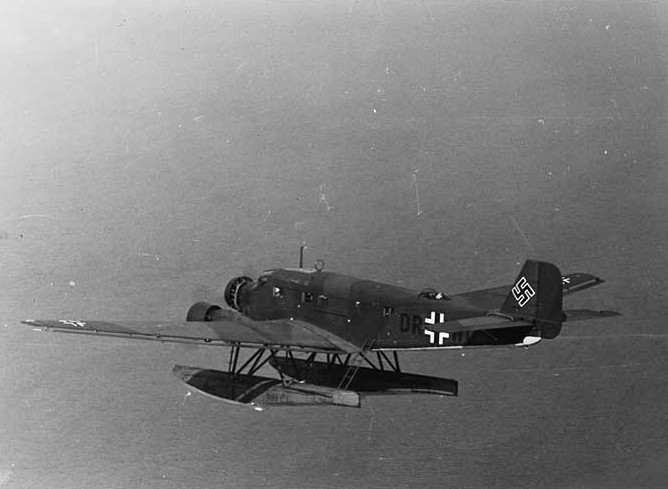
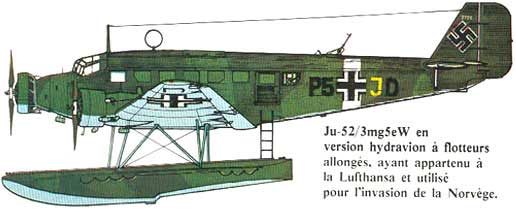
Then transferring them to Commander Ian Fleming and his lovely assistant Caroline Saunders in a motor boat to a Lysander STOL plane for safe flight to PLAN B neutral-throughout-WW2 fascist Spain.
 www.youtube.com/watch?v=fJCzTx7xMY0
www.youtube.com/watch?v=fJCzTx7xMY0
Lysander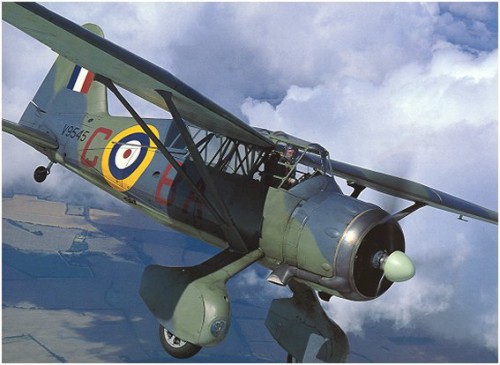
Sadly and strangely, both small and large American seaplane use has been decisive war winners to find, fight and sneak up on the enemy all the way to Vietnam in 1967.
www.combatreform.org/seaplanefighters.htm
American USAF special forces even used the Grumman Albatross SA-16/HU-16 seaplane with amazing clandestine results.
Black-camouflaged SA-16 for USAF Special Operations
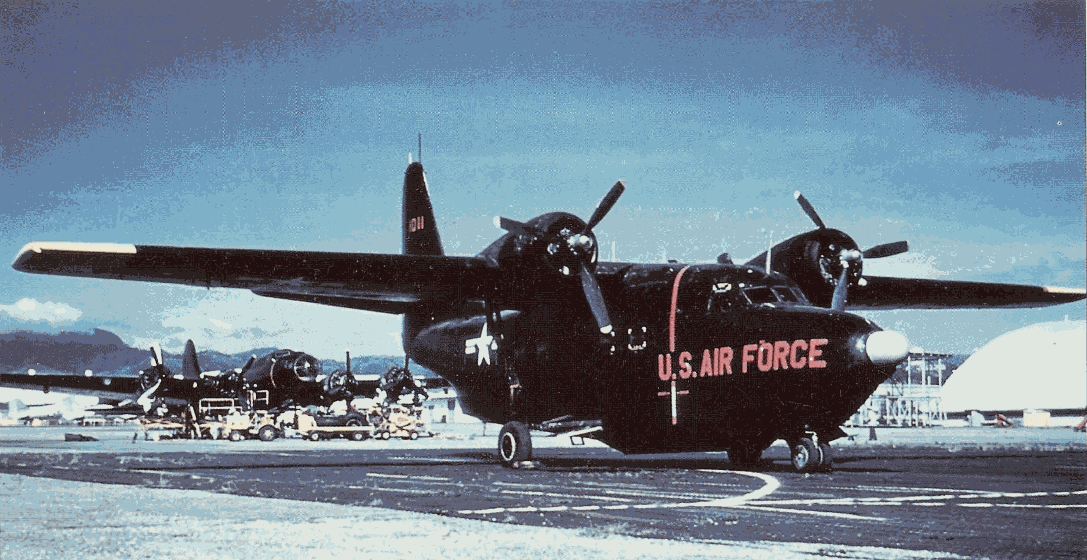
Then POOF!
The seaplanes were gone by 1970. The U.S. Navy bureaucracy run by the aircraft carrier mafia squeezed them out as a threat to their bloated aircraft carrier racket.
www.combatreform.org/p6mseamaster.htm
www.combatreform.org/seaplanetransports.htm
The USAF bureaucracy failed to inject even some modest funds to turboprop engine upgrade their SA-16/HU-16s that despite all their successes they transferred off to the Rhode Island Air National Guard because they threatened the ego and budgets of the fighter-bomber pilot jocks. This is what happens when the American people put selfish BUREAUCRACIES in charge of their common defense instead of PROFESSIONALS. They get the world's most expensive, immoral and incompetent military money can buy!
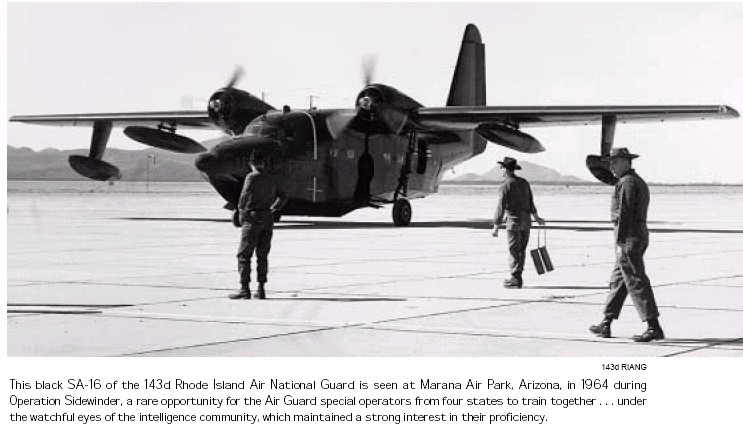
Even civilians could afford to convert SA-16/HU-16s to modernize them to turboprops! What's the USAF's excuse? They have none!
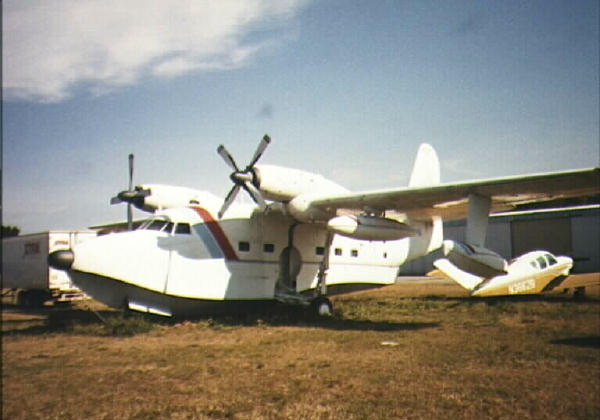
This SA-16/HU-16 has PODS under its wings for jet skis....U.S. Special Operations operates "ARC" jet skis today (see pic above from their airdrop manual)...but do not even have a fixed-wing seaplane that can land on the water to deliver and recover them!
FIGHT: The Last Gasp by Precision High Explosives, or Just the first of Many "Precision Guided Munitions" Attacks?
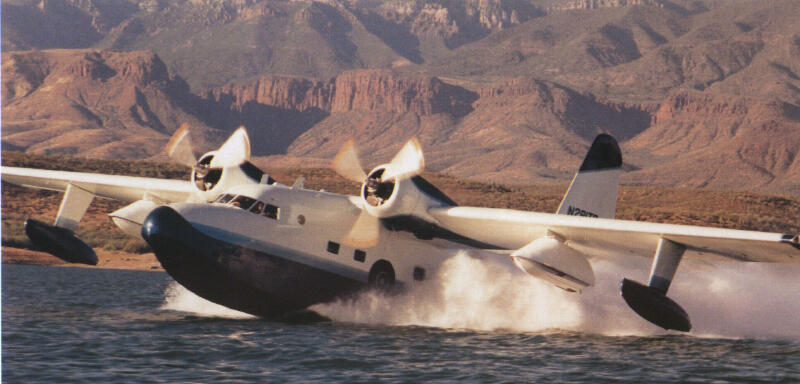

Nagasaki mushroom cloud delivered by a single USAAF B-29 heavy bomber
WW2 was a "garden hose" war where we sprayed areas with KE bullets and dropped unguided bombs and shot rockets in the general direction of targets such that there were more misses than direct hits.
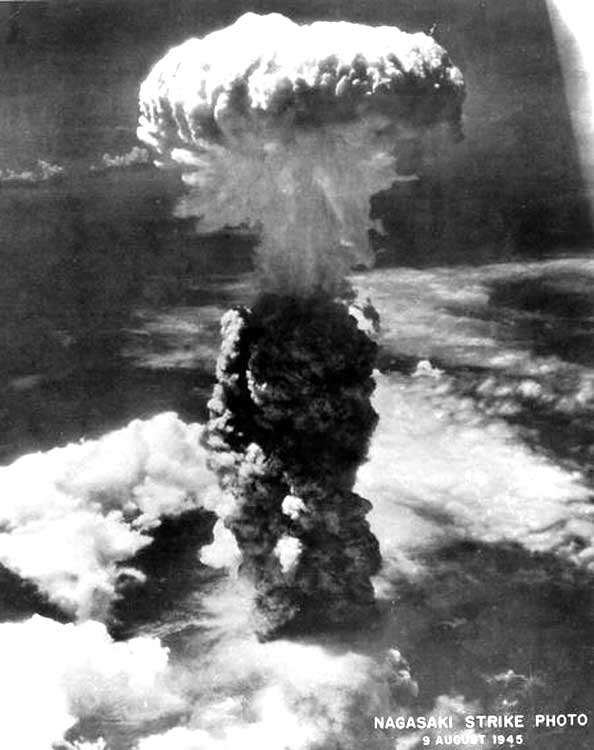
CIA miss-lead, Bay of Pigs 2506 Brigade B-26B armed to the teeth: 8 x .50 caliber heavy machine guns in the nose, rockets and napalm gasoline bombs under the wings--in addition to bombs or paratroops in the bomb bay! However, you have to get line-of-sight with your target and be in range to even get near misses!
To get direct hits, one had to shoot a lot and accept a lot of misses resulting in over 62, 000, 000 murdered in WW2 alone--along with lots of Europe and Japan burned to rubble or even ashes.
As WW2 came to a close, the Axis lacked the numbers to get HE effects from low-accuracy bombing. Their only hope to get destructive effect was by greater PRECISION by using electronic guidance or pilots willing to commit suicide and ram planes into their targets.
In contrast, the Allies with the numbers were not under the pressure of failure to improve accuracy like the Axis were. The super high explosive (SHE) nuclear bomb is just a magnification of the HE to a horrific degree to insure destruction.
However, you are not "winning" much of anything when nuclear contaminating the land for decades. If you want to take land that is still worthwhile to live on, one needs EFFICIENT military forces limited to HE weaponry and less that can direct effects against just military targets. War is a struggle of competing opposites like the children's game rock, paper, scissors as former Washington Post reporter Tom Ricks has rightly concluded, so as WW2 progressed, those receiving the HE "rock" began to apply the "paper" of smothering its effects by hardening important facilities in thick concrete and steel or go deep underground. The burrowing of evil entities around the world to evade American space satellite observation and possible air strikes has only increased since WW2. Notice what North Korean prisoners feared most from American firepower depicted in the USAF supplied picture below (wink) from retired Colonel Michael Hass' excellent book Apollo's Warriors USAF Special Operations in the Cold War.
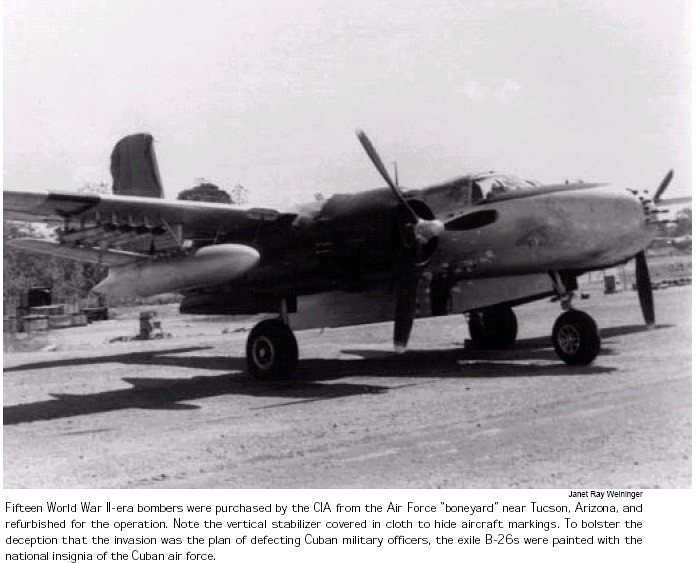
So while the foot-soldier has much to fear from air attack--they didn't have much to fear if OSS bureaucrat Allen Dulles--who was a traitor and double agent working for Nazi Germany--was sending back position reports to Washington!. Moreover, the hardened site does not have to fear the unguided bombing attack if its well-constructed like the German submarine pens were:
www.combatreform.org/highexplosives.htm
or even entire factories if they are underground and camouflaged:
www.combatreform.org/camie.htm
or if protected by Dulles-style POLITICAL CORRUPTION as American corporations and German factories built with Wall Street monies were OFF target lists during WW2:
www.combatreform.org/nazihydrainamerica.htm
So while the USSAF strategic bombing campaign failed dismally to make German say "Uncle!" and quit, it could have been more effective if AmeroNazi traitors like Assistant Secretary of War John McCloy were not deliberately helping the enemy. USAAF bombing was very effective when their bombers were concentrated into a swath to explode everything in front of our ground maneuver elements as Operation COBRA showed in 1944 which enabled us to get out of the French hedgerow country.
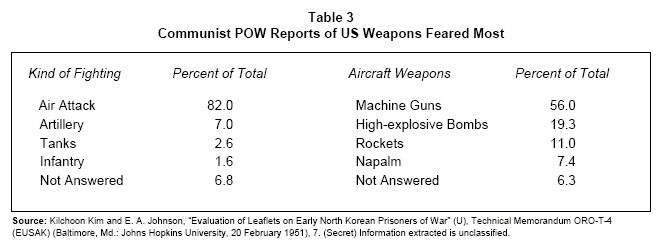
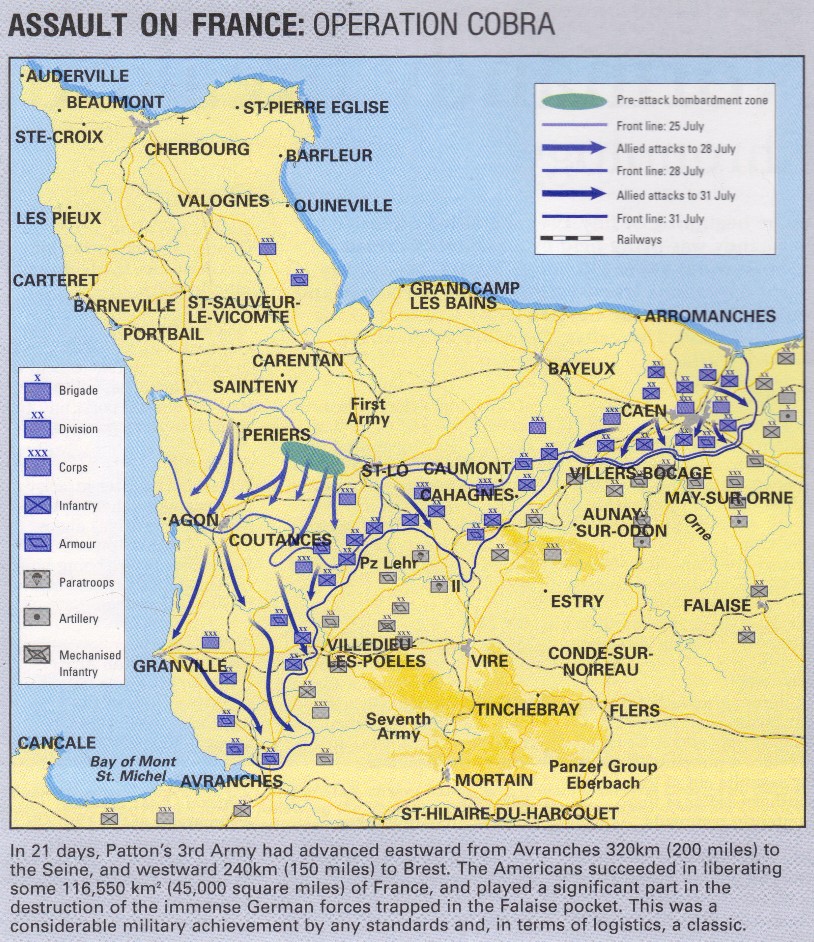
One idea that military men considered was GUIDANCE to direct high explosives to direct hit hard targets in order to destroy them. The Soviet Communists strapped bombs to dogs to take-out German tanks.
THE DOGS OF WAR--LITERALLY
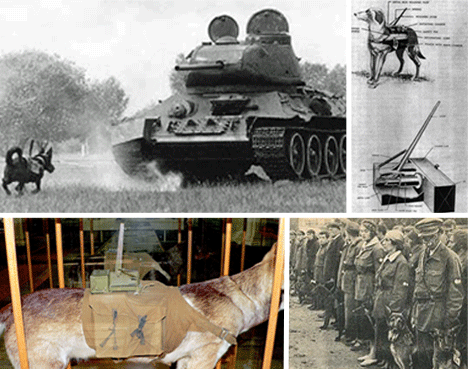
The Germans used guided HE means to sink ships and knock down bridges.
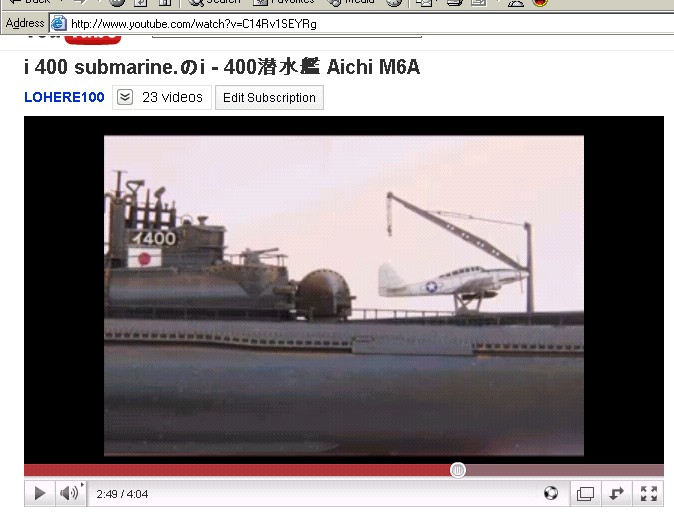
REFERENCE:
The artist's rendition above shows an I-400 with a Japanese attack plane in U.S. markings....we know the subs themselves had fake U.S. markings:
ww2db.com/ship_spec.php?ship_id=452I-400
Country: Japan
Ship Class: I-400-class Submarine
Builder: Kure Naval Yard, Japan
Commissioned: 30 Dec 1944
Sunk: 4 Jun 1946
Displacement: 5223 tons standard; 6560 tons submerged
Length: 400 feet
Beam: 39 feet
Draft: 23 feet
Machinery: Four diesel engines totaling 7,700hp, electric motors totaling 2,400hp
Speed: 18 knots
Range: 37,500nm at 14 knots
Crew: 157Armament: 8 x 533mm forward torpedo tubes, 20 x 533mm Type 95 torpedoes, 1 x 140mm gun, 3 x 25mm machine guns, 1 x 25mm machine gun
Submerged Speed: 6.5 knots
Aircraft 3 x M6A Seiran seaplanesContributor: C. Peter Chen
Submarine I-400 was the lead craft of her class of underwater aircraft carriers, capable of carrying up to three M6A Seiran seaplanes. Built at Kure, Japan, she (later joined by her sister submarines) became the largest submarine in the world, and would remain so until 1965. On 15 Dec 1944, Commander Toshio Kusaka was assigned as her commanding officer. On 30 Dec 1944, she was assigned to Submarine Division 1 of the Sixth Fleet. On 19 Mar 1945, she was strafed by American aircraft while in drydock at Kure, killing one anti-aircraft gunner. On 12 Apr, she departed Kure for Dairen, Manchuria, China, but was lightly damaged by a naval mine and had to return to Kure for repairs; she made the trip again on 14 Apr and made it to her destination successfully. She returned to Kure on 27 Apr. In May 1945, she was fitted with a breathing tube to allow her diesel engines to operate while she was submerged. In early Jun 1945, she conducted an exercise in Nanao Bay, launching six M6A Seiran aircraft operated by the 631st Naval Air Group.
I-400 was originally designed to attack faraway targets such as American coastal cities or the Panama Canal, but toward the end of the war when she was ready to launch an attack, a more realistic target was chosen. On 20 Jul 1945, she was dispatched from Maizuru harbor during Operation ARASHI in a force of two I-400-class submarines (I-400 and I-401, each carrying three aircraft) and two modified AM-class submarines (each carrying two aircraft) to attack the American anchorage at Ulithi in the Caroline Islands. On 22 July, she arrived at Ominato, Honshu, Japan, where all crew were granted one day's leave while all submarines in the group were painted with fake American markings. On the next day, she departed at 1400, taking a slightly different route toward Ulithi than the other submarines to avoid detection. Since the Japanese surrender was announced before the force reached their target, the mission was aborted on 18 Aug. All three I-400-class submarines fired their torpedoes and launched their aircraft into the water on 22 Aug 1945 before surrendering to the American destroyers Blue and Mansfield 500 miles northeast of Tokyo, Japan at 1200 on 27 Aug. At 0500 on 31 Aug, the American flag was raised above I-400 for the first time.
The Americans never learned of the existence of the I-400-class submarines until their crews surrendered. I-400 and I-401 were studied by the United States Navy at Sasebo, Japan between 1 Nov and 11 Dec 1945 and then at Hawaii, United States between 18 Feb and May 1946. As the Russians increased their demands to evaluate the Japanese submarines as well, I-400 was sunk as a target ship off Kalaeloa near Oahu, Hawaii on 4 Jun 1946 to prevent the Russians from doing so. She was sunk by three torpedoes launched by submarine USS Trumpetfish.
Sources: Nihon Kaigun, Wikipedia.
The Japanese were going to launch dive bombers painted to look like American planes from I-400 submarine aircraft carriers to knock out the locks of the Panama canal--a sort of aerial "Campbeltown" False Flag attack--but the war ended. We should locate the remains of the seaplanes the Japanese launched into the sea to ascertain if they were painted in American markings. Is Robert Ballard busy these days?
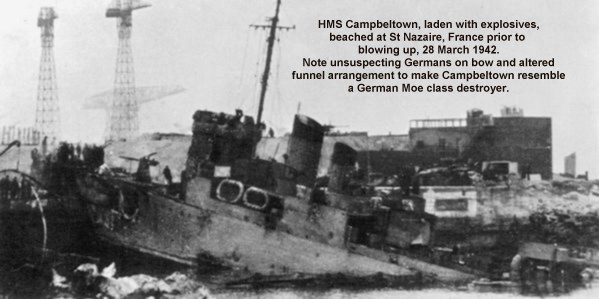
On the other hand, if the vessel wearing the false flag was moving at 20 plus mph and weighing several thousand tons like the Campbeltown, it would be usually too late too stop her with just KE guns. This principle of a heavy object allowed to gain momentum packed full of explosives has been repeatedly used since then, the truck bomb that blew up 241 lax U.S. marines in Beirut in 1983 is an infamous example of the military technotactical incompetence of our U.S. Military (USMIL) bureaucracy to understand and address HE threats:
www.combatreform.org/highexplosives.htm
Our lack of professionalism by the USMIL bureaucracy dominated by KE gunslingers in regards to HE threats continues to the present by our daily bleeding in wheeled trucks by HE land mines in Iraq/Afghanistan.
www.combatreform.org/WHEELSVSTRACKS/index.htm
Our kinetic energy (KE) bullet gunslinger narcissism and our absurd refusal to go cross-country in tracked tanks to avoid predictable paths the enemy can anticipate and lay mines and other ambushes for us is the primary cause of our 5, 000+ dead and 30, 000 wounded from Iraq/Afghanistan.
So while in WW2, both sides had to FIGHT to precision-place HE bombs to destroy high value targets (see parasite HE packed bombers and guided missiles below), today, we the incompetent USMIL bureaucracy, obliges the enemy by driving into their HE bombs for them. Its hard to not conclude that secret elites levels above even the corrupt U.S. nation-state government want the USMIL to bleed during the endless occupations of Iraq/Afghanistan for oil/drug profits to further their goals of weakening the U.S. so it has to sublimate itself into the New World Order (NWO)--and to effect a little depopulation to "thin the herd".
The Japanese were frustrated by our sophisticated HE sea mines which in 1945 had cordoned off their home islands and they lacked the counter-measures to stop us. Had we really been interested in winning the war ASAP, we would have taken islands down the Alaskan island chain into the Kuriles and sea mine blockaded Japan in 1942.
Japanese had no Counter to American Sea Mines
TOP SECRET WW2 Technical Report
The Allies frustrated by the German submarine pens and V weapons sites, packed bombers with unstable high explosives and remote control guidance means in order to hopefully fly under the thick roofs and into the sub pen openings. The catch was a HUMAN PILOT had first to take the dangerous combination off and then parachute (bail) out and endure a water landing and hopefully be rescued.
http://en.wikipedia.org/wiki/Operation_Aphrodite
APHRODITE B-17 drone
In an irony that is yet to be fully understood, oldest son, LT Joseph P. Kennedy Jr. USN was killed when his Project APHRODITE BQ-8 drone of a navalized B-24 Liberator maritime patrol bomber (PB4Y-1) packed full of explosives blew up in WW2 before he could bail-out--making it a Kennedy that flew the first Navy 9/11 style remote control ramming attack in 1944. Years later, another U.S. Navy plane with better technology not needing a human pilot to fly the drone at all succeeded ramming or flying very close to the U.S. military bureaucracy's own Pentagon building on September 11, 2001.
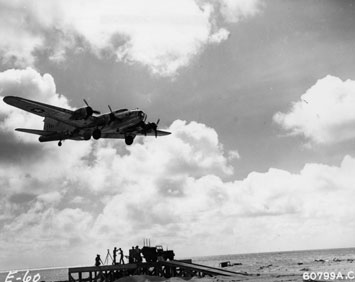
LT Joseph P. Kennedy Jr. USN
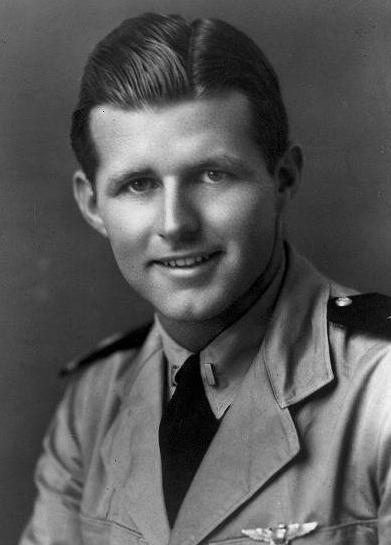
Operation APHRODITE was a series of bombing runs by explosive-laden aircraft piloted by a skeleton crew who would parachute from the aircraft before detonation. After U.S. Army Air Forces Operation missions were drawn up on July 23, 1944, Kennedy and Lieutenant Wilford John Willy were designated as the first Navy flight crew. Willy had pulled rank over Ensign "FNU" Simpson (who was Kennedy's regular co-pilot) to be on the mission.
They flew a
Following 300 ft (91 m) behind them in a
ATTEMPTED FIRST APHRODITE ATTACK TWELVE AUGUST WITH ROBOT TAKING OFF FROM FERSFIELD AT ONE EIGHT ZERO FIVE HOURS PD ROBOT EXPLODED IN THE AIR AT APPROXIMATELY TWO THOUSAND FEET EIGHT MILES SOUTHEAST OF HALESWORTH AT ONE EIGHT TWO ZERO HOURS PD WILFORD J. WILLY CMA SR GRADE LIEUTENANT AND JOSEPH P. KENNEDY SR GRADE LIEUTENANT CMA BOTH USNR CMA WERE KILLED PD COMMANDER SMITH CMA IN COMMAND OF THIS UNIT CMA IS MAKING FULL REPORT TO US NAVAL OPERATIONS PD A MORE DETAILED REPORT WILL BE FORWARDED TO YOU WHEN INTERROGATION IS COMPLETED
- Top Secret
telegram to General Carl Andrew Spaatz from General Jimmy Doolittle, August 1944Roosevelt's damaged Mosquito was able to limp home, some of the crewmen injured. Fifty-nine buildings were damaged in a nearby coastal town. The Navy's informal board of review rejected the possibility of the pilot erroneously arming the circuitry early and suspected jamming or a stray signal could have armed and detonated the explosives. An electronics officer had warned Kennedy of this possibility the day before the mission.
Kennedy was posthumously awarded the Navy Cross, the Distinguished Flying Cross, and the Air Medal. His Navy Cross citation reads:For extraordinary heroism and courage in aerial flight as pilot of a United States Liberator bomber on August 12, 1944. Well knowing the extreme dangers involved and totally unconcerned for his own safety, Kennedy unhesitatingly volunteered to conduct an exceptionally hazardous and special operational mission. Intrepid and daring in his tactics and with unwavering confidence in the vital importance of his task, he willingly risked his life in the supreme measure of service and, by his great personal valor and fortitude in carrying out a perilous undertaking, sustained and enhanced the finest traditions of the United States Naval Service.
Willy was also posthumously awarded the Navy Cross. The names of both men are listed on the Tablets of the Missing at the
Cambridge American Cemetery and Memorial, a cemetery and chapel near the village of Madingley in Cambridgeshire, Britain, that commemorates American servicemen who died in World War II.Ramming Planes Full of High Explosives? WHO Would think of Such a Thing?
WHO would be worried about U-boats?
WHO would be targeting V-weapons sites using Sidney Cotton's RAF photo intelligence?
WHO is sending 30 Assault Unit "Red Indians" in to recce these sites for air strikes?
Why of course, the British Admiralty!
And WHO runs the Admiralty's INTELLIGENCE section?
NID 17.
And who is the 2IC in charge of that?
Who is code-named 17F?
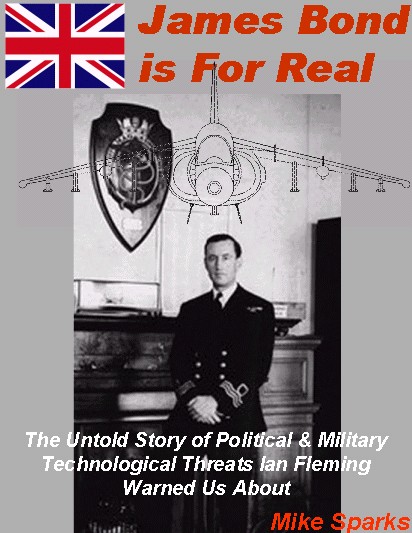
Commander Ian Fleming, RNVR.
WHO writes later in his 007 James Bond novel Thunderball about planes being hijacked...and False Flag attacks in Moonraker...art imitates life...
Details covered in our new book James Bond is Real!

"Everything I write has a precedent in truth"
--Commander Ian Fleming RNVR (1939-1951), MI6-SIS operative (1936-1964)
PROJECT CAMELOT TV PRESENTS: The James Bond is Real Televent, July 22, 2011, 5PM EST
Featuring the men who discovered the truth about Commander Ian Fleming, the Nazis, Ernst Stavro Blofeld, the Murder of President John F. Kennedy and much, much more!
* Mike Sparks
Watch Now: $10.00
Awesome Televent Artwork by Adrian of PROJECT CAMELOT!
JAMES BOND IS REAL IS HERE!
New Book Available Now:
lulu.com/product/paperback/james-bond-is-real-authors-edition/16174781

Click on the Camelot ROUND TABLE Televent Poster for Details!
* Jim Marrs
* Greg Hallett
* Dr. James Fetzer
* Dr. Jim Viken
By Mike Sparks
Paperback, 667 pages, ISBN: 978-1-257-84490-6
Most spy fiction and movie lovers know Ian Fleming as the inspiration behind the wildly popular James Bond series, but the seemingly harmless hero myth of Agent 007, is in fact Fleming himself, a former British naval intelligence commander during World War II, dropping hints and spilling secrets about the world's most dangerous people and associations. The terror organizations and doomsday devices found in the James Bond series were not merely dreamt up by Fleming, but were inspired by the intelligence he gathered during and after--World War II. Fans of James Bond, history, and military and spy conspiracy theories will be fascinated by the back-story of the now infamous spy novelist who warned of real danger in his engrossing series.
Spy?
Commando?
Playboy?
What Nazi Secrets did his 30 AU Commandos Find?
What Are His Warnings in His 007 Novels?
Was he Murdered?
James Bond is Real, Book Available Now!

Want James Bond is Real Signed by the Author?

The Author isn't famous like Daniel Craig, but Maybe Someday Having His Book Signed by Him Proves that you were a direct participant in these startling revelations! Click on the PayPal button below for an author's signed copy:
YOUTUBE Video
 http://youtu.be/l2ojbyuUP98
http://youtu.be/l2ojbyuUP98
Praise for James Bond is Real:
"Who knew that the man who planned the escape of Nazi Deputy Fuehrer Martin Bormann, and perhaps even Adolf Hitler himself, was Ian Fleming, the creator of the James Bond book series? Learn of this incredible 1945 plan, ironically code-named 'James Bond' and much more hidden history, in Mike Sparks' new book which documents how Fleming, far from a mere desk-bound bureaucrat, was the real James Bond."
--Jim Marrs, New York Times Best-Selling author of Rule by Secrecy, The Rise of the Fourth Reich and The Trillion-Dollar Conspiracy
"Mike Sparks' work is the missing link in the how-to of Military Intelligence land. The emerging reality we are living in now, was very definitely begun by Ian Fleming in his time. Fleming was the 'make-it-happen' genius of his time with more contacts than an H-bomb. When there are missing gaps in my own history, Sparks has it covered"
- Greg Hallett, Lord Chancellor to Exiled King of England, Author, Hitler Was a British Agent
"Mike Sparks has proven to be one of the most brilliant and insightful students of covert activities I have ever known. When he tells us, 'James Bond is real!', you can take it to the bank."
-- James H. Fetzer, Ph.D., Founder, Scholars for 9/11 Truth; assassinationscience.com; Editor, Murder in Dealey Plaza
Liberal Kennedies vs. the AmeroNazi Fascists, Round 1
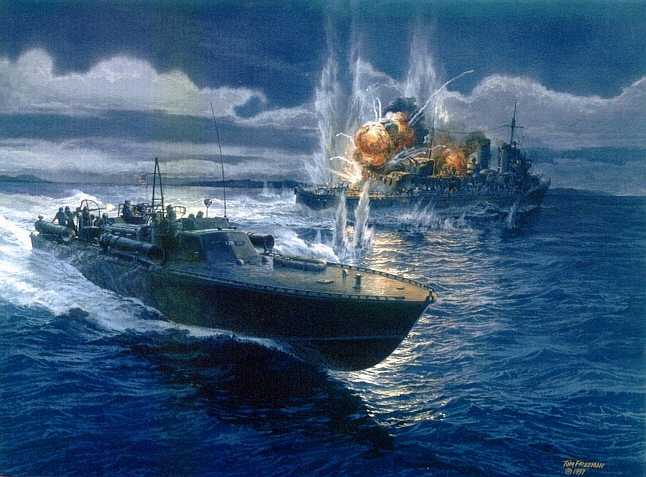
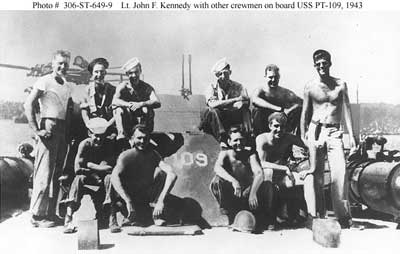
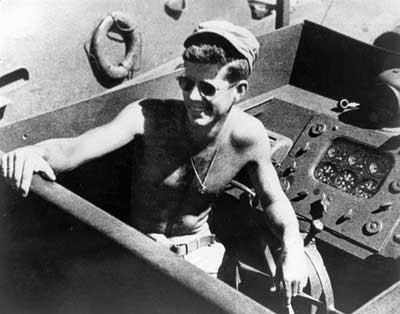
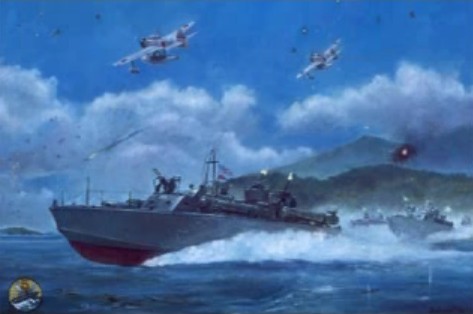
Office of Strategic Service 1942-45: The World War II Origins of the CIA by Eugene Liptak on page 62 states:

Thus, PT Boats are also handy for Special Operations...
Tragically, without Joseph Kennedy Jr., this left second-eldest son, fast PT boat commander LT. John F. Kennedy to live the elder Kennedy's dreams and someday become President of the United States (POTUS). So it could be said in a way, the Nazis murdered the eldest Kennedy son and also killed the next eldest--since the CIA was founded by AmeroNazis in 1947 because the British-created OSS--even purged of those pesky liberals--was still not fascist enough for them. As POTUS, JFK had the ill-conceived 1961 Bay of Pigs CIA invasion of Cuba foisted upon him and when it failed after he fatally tinkered with the plan;
The Bay of Pigs Operation Could Have Succeeded
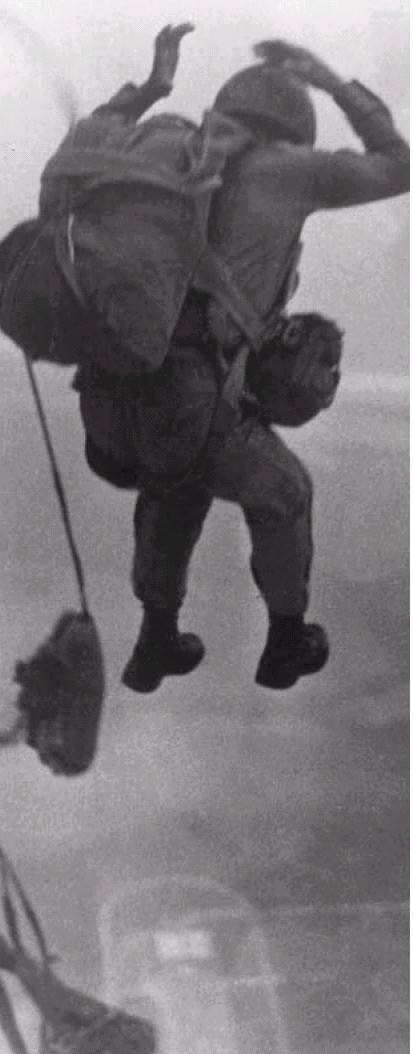
You fail jump school! WTFO? Get those hands on the left and right side of your reserve! Feet and legs together! The Cuban 2506 Paratroopers did fantastic at the BOP later on....but this jumper is no poster child for jump technique!
www.combatreform.org/airbornebayofpigs.htm
...he fired AmeroNazi CIA Director Allen Dulles--but left him in power for the rest of the year to plot his murder revenge with BG Ed Lansdale USAF!
The CIA (Dulles & Lansdale) and VPOTUS LBJ Murdered JFK
www.combatreform.org/THEJFKRESEARCHSITE/index.htm
Thus, its no stretch of the facts that the CIA Nazis were involved in the next brother's murder in 1968 when Robert F. Kennedy (RFK) was about to become the Democratic party front-runner (Sirhan Siran MKULTRA-man as the patsy) nor that they smeared youngest brother Ted by staging a car accident drowning of his secretary and murdered JFK's son John-John by having a MKULTRA mind-controlled instructor pilot dive the plane into the water as researcher John Hankey proposes or explode a bomb. What's really disgusting is how two women were on board and murdered with him. Its as if the current generation of demented Nazis has even less decency than their forebears--who at least took steps when shooting JFK with high-power rifles not to kill Jackie Kennedy and Nellie Connolly.
The final irony is that ramming airplane into a target is a WW2 IDEA that a Kennedy brother lost his life trying to do to defeat the Nazis and almost 60 years later was copy-catted by the same Nazis to ram their own Satanic symbol Pentagon building to stage a "New Pearl Harbor" to con the American people into a never-ending war for corporate profits!
How the Nazis Gave us 9/11
www.combatreform.org/seeingisNOTbelieving.htm
WW2 Deja Vu All Over Again: "757 SkyWarrior" False Flag APHRODITE-style Plane
The ultimate con job was the September 11, 2001 attacks where it appears a retired U.S. Navy A-3D SkyWarrior carrier bomber converted into a drone plane was remotely flown into or over the Pentagon wearing the markings of an American Airlines airliner sufficient to con any honest witnesses (if any) on the ground into thinking Islamic ragheads hijacked the alleged Flight 77 that day and committed group suicide.
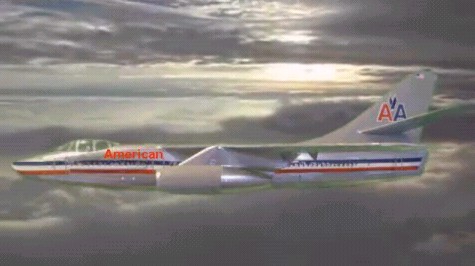
 www.youtube.com/watch?v=xbw-SWxqzKI
www.youtube.com/watch?v=xbw-SWxqzKI
The Pentagon Explosions on 9/11 Give Away the Entire Militarism Con Job
www.combatreform.org/911pentagonrealitycheck.htm
The Pentagon got their never-ending war with Islamic ragheads to be their cash cow and "Cooked the books" of a pesky $2.3 TRIILION dollar mismanagement of funds left over from the last "Cold War" bogeyman by murdering 125 Navy accountants positioned for the attack on the west side of the building.

One last thought. The evil Germans are if anything clever and efficient once their "hive" is steered by someone brilliant in the right direction. Without constructive criticism this is a real problem in groupthink systems. While their robotic bomber "UAVs" were still limited by the same crude remote control technology as us, they came up with a better low-tech arrangement to get the pilot away safely and then have him CONTROL the bomber to its targets: they placed him in a fighter plane piggy-back on top of the bomber--the "Mistletoe" concept. Once detached from the HE-laden bomber, he steered it to the target, then flew back to base. He could even defend himself with his own machine guns and cannon to get back safely. Pilot skills were honed by flying training Mistels combinations depicted below.
Training Mistel combination
The Germans were--unlike the Allies--successful at steering Mistel bombers to strike hard targets and destroy them in WW2.
German Hs293 air-to-ground guided missiles
Moreover, they developed smaller HE missiles than turning manned aircraft into "cruise missiles" that also were successful at sinking several U.S. warships. Thus, the American claim that we invented Precision Guided Munitions (PGM) warfare--is yet another Pentagon LIE by unprofessional, immoral bureaucrats. The USMIL bureaucracy cannot even do treason well without lying about it.
Naval PGM Warfare Dooms Bloated Surface Ship Aircraft Carriers
www.combatreform.org/USNAVYINDANGER/midwaymyth.htm
All of this immoral and incompetent USMIL bureaucracy does not bode well for America's future and must be discarded by developing a PROFESSIONAL force based on Judeo-Christian morality and anti-racketeering efficiency.
REFERENCES
http://greyfalcon.us/KG%20200.htm
KG 200 was the special operations battle wing ("Kampfgeschwader") which operated captured allied bombers, worked as path finders and flew missions to bring secret agents behind enemy lines etc.
He-115 seaplane
The first group of KG 200, I./KG 200, flew a total of 3-4 He 115's and were responsible of dropping Abwehr agents behind enemy lines. The largest number of agents dropped by I./KG 200 was in July 1944, where a total of 260 men and women were dropped, mainly using automatic parachutes. The total number of agents dropped between June 1944 to March 1945 were 600. Out of these, 5-10 were women.
Between July 1st and October1st 1944, I./KG 200 dropped 157 agents in 11 major operations on the western theatre. In the same period, 114 minor operations were flown by I./KG 200 through its Frontaufklärungskommandos in combination with the responsible Ic-Abt.
The I./KG 200 was divided into three squadrons ("Staffeln"):
1st squadron: missions in distant areas ("Ferneinsätze")
2nd squadron: missions in near areas ("Naheinsätze")
3rd squadron: navy pilots ("Seeflieger")
The 3rd squadron of KG 200 had one He-115, located in Rissala/Finland. [Gellermann 4]
The second group of KG 200, II./KG 200, had one Staffel for commando raids, the 3rd Staffel. They were located and trained in Dedelstorf, Germany. In September 1944, this Staffel was no longer under the command of KG 200, but under the Army Paratroopers command as "Bataillon Schäfer".
The abbreviation for Küstenfliegergruppe was Kü.Fl.Gr. or St. for Staffel. All these units [KG 200 and KüFlGr] were under command of Gen. D. Lw b. Ob. d. M [General der Luftwaffe beim Oberkommande der Marine und Befehlshaber der Marinefliegerverbände und zugleich Inspekteur der Marineflieger (L.In. 8)] in Berlin until 7.9.1944, then this command-position was striken.
Luftwaffe's Secret KG 200
KG 200 took part in many covert missions against the Allies and became the subject of much postwar speculation
The history of the German Luftwaffe in World War II has been examined by scores of authors and eyewitnesses. The case of Kampfgeschwader (Battle Wing) 200, or KG 200, is a different story, however. The real story of this special Luftwaffe unit has remained shrouded in mystery, and most members maintained their silence after the war. The commander of the unit, Colonel Werner Baumbach, a winner of the Knight's Cross and a celebrated Junkers Ju-88 bomber pilot, did not even mention KG 200 in his memoirs, Broken Swastika.
Werner Baumbach was a bomber pilot in the German Luftwaffe during World War II and commander of the secret bomber wing KG 200.
Born on December 27, 1916 in Cloppenburg, Baumbach entered the Luftwaffe in 1936 and was trained as a bomber pilot. He was one of the first pilots to fly the Junkers Ju-88 bomber and flew various bombing missions with KG 30.
In 1942, Baumbach was removed from active pilot duty and started working on new bomber designs; among others, he helped design the composite bomber system Mistel.
In 1944, he was placed in command of the newly-formed KG 200 and was in charge of all Luftwaffe special missions.
After the war, Baumbach spent three years as a prisoner of war before he moved to Argentina where he worked as a test pilot. He died in a plane crash on October 23, 1953.
Baumbach released his memoirs, "Zu spät: Aufstieg und Untergang der deutschen Luftwaffe" (English title: "Broken Swastika"), in the late 1940s. The book demonstrates that even after Germany's defeat, Baumbach still believed to a very large extent in the National Socialist ideology.
The fact that Baumbach's time as commander of KG 200 is not mentioned with a single word, highlights the extreme secrecy of Germany's special missions program.
KG 200 was a unique unit, which operated a wide variety of aircraft--from the Blohm und Voss Bv-222 Wiking (the largest flying boat of the era) to the Junkers Ju-52, Ju-90, Ju-290 and Ju-188, the Heinkel He-111, and even captured British and American aircraft such as the Consolidated B-24 Liberator and the Boeing B-17 Flying Fortress.
B-17 "Flying Fortress"
The earliest incarnation of KG 200 was Special Squadron Rowehl, a unit subordinate to the Abwehr, the German military intelligence organization. Colonel Theodor Rowehl, who had been a reconnaissance pilot in World War I, heard rumors that Poland was building new forts along its border with Germany. Now a civilian, Rowehl began flying photo reconnaissance missions over Poland in civilian aircraft. (Military planes were not allowed to fly in that area.) The Abwehr was impressed with Rowehl's photographs and paid him to continue his flights. From 1930 to 1934, Rowehl flew solo reconnaissance flights as a civilian. A short time later, he put together a squadron of airmen that was given an official military designation. His efforts led to the creation of a unit operating for the Luftwaffe's 5th Branch (air intelligence). The new unit flew high-altitude photo reconnaissance missions over all of Europe, Africa and the Soviet Union in a wide variety of military and civilian aircraft.
Note: the Allies had WW1 combat pilot Sidney Cotton do the exact same kinds of civilian spy missions before the war! And during the war, he created his own photo recon outfit!
During the late war period, when the Abwehr fell under a cloud of mistrust due to anti-Hitler activities, the prestige of the squadron suffered through its association with the intelligence arm. Captain Karl Edmund Gartenfeld, a specialist in long-range reconnaissance and navigation and in inserting agents behind enemy lines, formed his own new unit in the summer of 1942. By 1944 his squadron, the 2nd Test Formation, had grown to a group of four squadrons.
KG 200 was officially formed by order of the air force high command on February 20, 1944. In March 1944, the 2nd Test Formation was united with the 1st Test Formation, a research squadron. This combined unit came under the command of then Lt. Col. Werner Baumbach and was renamed KG 200. The 2nd Test Formation became the first group of the new KG 200, and Gartenfeld was replaced by Major Adolf Koch. Within days, 32 types of aircraft were ready for use, complete with 17 fully trained crews. Heavy training began at once, and by the end of July 1944, five new crews were ready, and refresher classes had been provided for 75 additional crews. Even at this early stage special missions were already being flown.
KG 200 was divided into several sections, each of which had subsidiaries across the German empire. The first group (I/KG 200) handled agent work; the first squadron (1/KG 200) handled long-distance operations; 2/KG 200 covered short-range operations from various "outstations"; 3/KG 200 was concerned with transport and training duties and was based at the Baltic island of Ruegen, later Flensburg; 4/KG 200 handled technical matters. The second group (II/KG 200) provided pathfinders, radar-jamming aircraft, bombers and Mistel composite aircraft; 7/KG 200 handled replacement and training for II/KG 200.
The first two groups of KG 200 were the only ones ever fully developed, although several other projects were planned. III/KG 200 was to have fitted Focke-Wulf Fw-190 fighters with torpedoes but was never inaugurated. IV/KG 200 was the training and replacement group for KG 200 and trained the nearly 100 "self-sacrifice" pilots who flew the Reichenberg modified V-1 suicide weapons. KG 100, which handled Fritz X and Hs 293 guided missiles, was also associated with KG 200. The fifth long-range reconnaissance group flew Ju-90s and Ju-290s on their missions. The test unit of the Luftwaffe commander flew high-altitude reconnaissance and testing aircraft and also conducted evaluation flights of captured Allied aircraft.
Before we concocted Islamic ragheads flying Kamikaze airliners into buildings the German Nazis created a MANNED version of their V-1 buzz bomb for air-launch
2/KG 200 covered different combat fronts from various outstations. The headquarters of each outstation was located in a wooded area, and the airfield had to appear abandoned during the day in order to avoid unwanted Allied scrutiny. Outstation Carmen, in northern Italy, covered the western Mediterranean, the southern Mediterranean, and North and West Africa. Outstations Klara and Toska handled the Eastern Front, and Detachment Olga covered Western Europe, England, Ireland and Iceland (and later took over Carmen's areas as well).
By 1944, because of the increasing action on the Western Front, Detachment Olga at Frankfurt am Main was very busy. Olga was commanded by P.W. Stahl, an experienced pilot who had flown supply missions in the fall of 1942 to Finnish long-range reconnaissance units operating deep in Soviet territory. His book, KG 200: The True Story, is one of the few accurate accounts of the unit.
Secret Missions
Ju-188
Despite its importance, Outstation Olga was little more than a rough runway beside a forest. The command post consisted of two huts hidden in the woods. The operational aircraft included six Junkers Ju-188s and a pair of captured and renovated Boeing B-17s, re-designated Dornier "Do-288s". Enemy "Jabos," as the Germans called Allied ground-attack aircraft, were overhead so often that personnel took the precaution of dodging from tree to tree, never appearing in the open during daylight.
"Do-288"
Detachment Olga was responsible for landing agents in France, which was under Allied control. The KG 200 pilots usually dropped agents by parachute, but on some flights they would drop a personnel drop device--a metal and plywood container holding three agents and their equipment that would parachute to earth. The KG 200 pilots made supply runs to keep their covert activities in operation.
Agents were trained at the Reich Main Security Office's well-fortified luxury hotel, on a mountain in southwestern Poland. The hotel was ringed by guards and could be reached only by cable-car. Upon graduation, the new agents were sent to KG 200 for transport to their areas of operation.
These secret missions were only flown at night, and the runway lights were turned off as soon as the aircraft had taken off or landed. Under cover of darkness, as they dropped their passengers or acted as airborne listening posts, the KG 200 pilots and planes were relatively safe from attack. Landing was another matter; the airfields often came under attack and were extensively damaged while the KG 200 pilots were in the air, making landing impossible and leading to the loss of airplanes and crews.
Pressed by a shortage of long-range aircraft, KG 200 used captured Allied aircraft--given German markings--to fly their missions. Phyllis Marie, a Boeing B-17F, was one example. Phyllis Marie went down with battle damage on March 8, 1944, at Werben, Germany. The plane was captured and repaired from the large stock of B-17 spare parts that the Germans had amassed during the years of heavy daylight bombing attacks by U.S. planes. Maltese crosses were painted on the wings and a raked swastika on the rudder, but otherwise Phyllis Marie remained unchanged. U.S. forces recaptured the plane on a runway at Altenburg on May 4, 1945.
By July 1944, the war was turning against the German Reich on all fronts. Ernst Kaltenbrunner, commander (under commander in chief of the SS, Heinrich Himmler) of all SS intelligence operations and head of the Reich Main Security Office, informed the KG 200 operations officer that he needed to provide a plane that could fly almost to Moscow, land and unload cargo and people, all unnoticed. The purpose of that mission, code-named "Operation ZEPPELIN," was to kill Josef Stalin. The aircraft chosen for the job was the Arado Ar-232B--a 4-engine version of the Ar-232A Tatzelwurm (Winged Dragon)--known as the Tausendfüssler (Millipede) because of the 11 pairs of small idler wheels under the fuselage that were used to land on unprepared fields.
Ar-232B
On the night of September 5, two agents, their baggage and their transport were loaded aboard, and the Ar-232B took off. The agents intended to reach Moscow, where they had a place to stay. They carried 428,000 rubles, 116 real and forged rubber stamps and a number of blank documents that were meant to gain them entry to the Kremlin so that they could get close to Stalin.
There was no word from the plane until long past its maximum projected flying time, and it was assumed lost. Then a radio message came from one of the agents: "Aircraft crashed upon landing, but all crew members uninjured. Crew has split up into two groups and will attempt to break through to the west. We are on the way to Moscow with our motorcycle, so far without hindrances." The two would-be assassins were later captured at a checkpoint when a guard became suspicious of their dry uniforms on a rainy day. Some of the German crew did manage to make it back to friendly lines, but others had to wait until the end of the war to return.
Bizarre schemes and deceptions such as the Stalin assassination plot came from both sides. In October 1944, an agent who had been dropped behind Russian lines suddenly resumed contact with his controller in Germany with an astonishing story to tell. He was in contact with a large German combat group--2,000 men strong--that was hiding in the forested and swampy region of Berezino, roughly 60 kilometers east of Minsk. The Germans, under the command of a Colonel Scherhorn, had been caught behind Russian lines during the Wehrmacht retreat that summer. German intelligence accepted the report as true. KG 200 was dispatched to provide the German troops with supplies that the German high command hoped would allow "Kampfgruppe (Battle Group) Scherhorn" to break out and return to German lines. Not until April 1945 did the Germans learn that "Colonel Scherhorn" was in fact a Soviet operative using the name in an elaborate ruse.
KG 200 was also in charge of the German suicide pilots. The Germans mirrored the Japanese kamikaze efforts with the Reichenberg IV suicide bomb. The concept was developed by a glider pilot who was a veteran of the famous 1940 assault on the Belgian fortress of Eben Emael. As the war turned against Germany and his fellow pilots were slaughtered, he thought that if glider pilots were to be sent to perish, they should be armed with a suitable weapon to bloody the enemy. The Reichenbergs were to be piloted by "self-sacrifice men." Thousands of men volunteered for vaguely defined "special operations," and 70 of them were sent to KG 200.
Although these men were trained on gliders, they were to fly a manned variant of the V-1 buzz bomb. The V-1, also known as the Fiesler Fi-103, was already in mass-production for its primary purpose as a flying bomb. The German Research Institute for Gliding Flight at Ainring modified the V-1 to carry a pilot. By 1945, however, the attitude toward using the flying bomb had changed so much that only criminals or pilots who were in a depressed state or were ill would be allowed to fly Reichenbergs.
Operation IRON HAMMER
As early as 1942, researchers also began to develop Mistel (mistletoe), a piggyback aircraft--a smaller aircraft mounted above a larger, unmanned aircraft such as a medium-sized bomber. After a series of false starts, the combination settled upon was a Messerschmitt Me-109 or Focke-Wulf Fw-190 fighter atop a Junkers Ju-88 bomber. The machines were joined by a three-point strut apparatus, which was fitted with explosive bolts that would sever the connection when the carrier aircraft--armed with an 8,377-pound hollow-charge warhead in the nose--had been aimed at its target. The warhead would detonate on impact in an explosion that could penetrate 8 meters of steel or 20 meters of ferroconcrete.
By May 1944, the first operational Mistels were delivered to 2/KG 101, a unit closely affiliated with KG 200. The unit was originally slated to attack Scapa Flow in northern Scotland, but the Allied invasion of Normandy changed that plan. On the night of June 24, 1944, Mistels were dispatched against targets in the Bay of the Seine, in the English Channel. Although one of the Ju-88s had to be jettisoned prematurely, the remaining four pilots had successful launches and sank several block ships.
Luftwaffe planners placed all Mistels under the aegis of KG 200 and Colonel Joachim Helbig, an expert Ju-88 pilot. Task Force Helbig was handed a daunting and audacious plan--it had been decided that the Mistels would be used to single-handedly cripple the Soviet war industry. The operation, known as Plan Iron Hammer, was the 1943 brainchild of Professor Steinmann of the German Aviation Ministry, who had pointed out the benefit of raiding selected points in the Soviet infrastructure in order to damage the whole. Iron Hammer was meant to attack the Soviets' Achilles' heel--their electrical generation turbines. The Soviets relied on a haphazard system of electrical supply with no integrated grid, which revolved around a center near Moscow that supplied 75 percent of the power to the armament industry. The Germans sought to destroy an entire factory system in one quick blow.
The mission called for KG 200 to launch strikes against power plants at Rybinsk and Uglich and the Volkhovstroi plant on Lake Ladoga. The planes were to drop Sommerballon (summer balloon) floating mines. In theory, a Sommerballon would ride the water currents until it was pulled straight into the hydroelectric turbines of a dam, but the weapon never performed as designed. In addition, the unit soon became short on fuel, and the operation was halted.
Iron Hammer was resurrected in February 1945, with several new twists. The Soviets had overrun all the advance bases included in earlier planning, so the attack would have to be launched from bases near Berlin and on the Baltic. Mistels would now be the primary weapon. Furthermore, Iron Hammer had become a part of a master strategy to regain the initiative in the East. After the strike rendered the Soviet production centers impotent, the Wehrmacht would wait until the Soviets had exhausted their front-line materiel. Freshly rearmed Waffen SS divisions would swarm northward from western Hungary, attempting to drive straight to the Baltic Sea and catch the advance elements of the Red Army in a huge pincer movement. After the Soviets had been eliminated and Central Europe was safe, the Germans would negotiate a separate peace with the Western Allies, and the struggle against Bolshevism could be continued. Iron Hammer was never launched, however. American daylight raiders destroyed 18 Mistels at the Rechlin-Laerz air base. With this main strike force gone, the entire mission was rendered moot even before Iron Hammer was officially cancelled.
On March 1, 1945, Hitler appointed Colonel Baumbach to the post of plenipotentiary for preventing Allied crossings of the Oder and Neisse rivers. At his disposal were Mistels and Hs-293 guided bombs. On March 6, an Hs-293 hit the Oder bridge at Göritz. The same bridge was attacked two days later by five Mistels escorted by Ju-188 bombers. The Ju-188s scattered air defences, and the Mistels destroyed two bridges.
These victories and those in following days did little to change the inevitable outcome of the war. KG 200's remaining pilots and machines were shuffled to various air bases in futile attempts to destroy the Oder bridges. In Berlin, Baumbach was replaced by another officer, who released the KG 200 headquarters group on April 25, 1945. Some men changed into civilian clothes and attempted to reach the Western Allies, while others proceeded to Outstation Olga to continue the fight.
The American advance into Germany forced the relocation of Outstation Olga from Frankfurt am Main to Stuttgart, and then again to the Munich area, where the unit settled inside a Dornier aircraft factory. Stahl and company continued their duty until the situation became untenable. He issued discharge papers and a final service pay and said goodbye to his men.
After the war, the Allies sought out members of the "ominous secret group," sure that they had been involved in spiriting Nazi officials out of Europe. The continuing mysteries and half-truths about KG 200 prompted Stahl to write KG 200: The True Story, "to clear up this business of 'Hitler's spy Geschwader.'" He also attempts to justify his unit's record: "The fact that not a single former member of KG 200 has ever been accused of any specific misdeed, never mind prosecuted, speaks for itself."
www.kg200.com
Luftwaffe Bomber Wing KG 200
This top secret Luftwaffe unit flew the most special missions with the most special aircraft
Luftwaffe secret weapons - everyone knows about Germany's V-1 and V-2 missiles and the Luftwaffe jet and rocket aircraft, but they were no real secret, even during the war, as London's civilians and allied pilots knew about them and saw them in action, and allied intelligence knew about them even earlier.
This is about the most secret Luftwaffe unit, which operated its most secret aircraft and flew its most special missions. A ghost unit which became known to allied intelligence only after World War 2 ended. This is the story of Luftwaffe wing 200.
Every large air force has squadrons and aircraft for strategic intelligence missions and for missions requiring the use of special aircraft and special weapons. Sometimes "innocent" civilian aircraft are being used for espionage missions, or even a few captured enemy aircraft.
There are also units that test fly experimental and captured aircraft. These special and secret aircraft are usually flown by the most experienced and skilled pilots, and covered by the deepest secrecy, often for decades. For example, in the post-war United States these were the SR-71 Blackbird spy plane, the stealth aircraft, the CIA-operated aircraft, and the captured Russian aircraft and experimental aircraft flown from Area 51 in Nevada, nicknamed Dreamland.
In Nazi Germany, the top secret Luftwaffe unit code-named Bomber Wing 200 (KG 200) was all that.
Civilian aircraft photo recon flights
When the German military began to prepare for World War 2, it needed air photos of the countries it intended to invade. Since flights by the standard Luftwaffe photo recon aircraft were not just violation of those countries airspace but also a clear warning sign of German intentions, the German military intelligence used aerial cameras carefully hidden in German passenger and commercial aircraft which flew over those countries.
The rise in landing delays by the formerly precise German pilots made the polish intelligence suspect that the innocent civilian German aircraft are used for photo reconnaissance, but they could not find the hidden cameras, when they checked those aircraft when they landed in Polish airports.
The Luftwaffe operated civilian aircraft for photo recon missions all over Europe and north Africa before and during world war 2. Initially the aircraft belonged to the German military intelligence, but during the war they were assigned to the Luftwaffe.
When World War 2 started, German spies and saboteurs had to be inserted to or extracted from allied countries. Some were inserted or extracted by German submarines, some traveled via neutral countries, and some, like many allied secret agents, parachuted from Luftwaffe aircraft.
Flying all Luftwaffe special missions
In February 1944, Luftwaffe headquarters ordered that all strategic and covert aerial reconnaissance, secret agent deliveries, special delivery flights to Japan, and experimental aircraft testing, in fact all special missions, will be concentrated in one new unit, code-named bomber wing 200. The commander of the new unit was Werner Baumbach, a very experienced and highly decorated bomber pilot and leader who survived over four years of bombing missions over enemy territory, over France, Britain, Russia, and elsewhere.
KG 200 was made of several large squadrons. It was also geographically spread in multiple bases all over Europe. The total secrecy in KG 200, as common in such top secret units, was such that its people knew very little of each other's activity, to minimize security breach in case of captivity. It had over 100 air crews and operated over 30 different German and allied aircraft types.
The 1st squadron of KG 200 was in charge of flying German secret agents to and from allied territory. It had a long-range group, and a short-range group which was spread all over Europe. It got its operational orders directly from the SD, the Nazi party's intelligence service.
The 2nd squadron of KG 200 was in charge of all other operations, including electronic warfare and special bombing missions, long range patrols as far as the U.S. east coast, and special cargo missions which flew all the way to Japanese held north China. It operated from hidden airstrips all over Europe, usually near forests, used to hide their special aircraft from allied pilots.
Additional squadrons which were established but did not become operational before the war ended, were the German suicide attack unit, equipped with a human-piloted version of the V-1 cruise missile, and a very long-range squadron intended to reach the U.S. east coast and other remote targets.
All secret agent delivery missions were night missions, to further minimize exposure to the enemy, and they relied on the navigation skills of the navigators, which were the best and most experienced navigators in the Luftwaffe.
To further minimize the risk to both pilots and agents in secret agent insertion missions, especially when a team of agents was involved, the Luftwaffe developed a special human air drop device. It was a bomb-like cylinder carried by a bomber, in which three secret agents and their equipment could be safely dropped from the bomber to the enemy ground. The cylinder was equipped with a parachute, a telephone which enabled the secret agents to speak with the bomber pilot during the flight, and a shock absorber to further ease the landing. It allowed the German intelligence to safely land single, or teams, of secret agents in enemy territory, with heavier equipment and without the common risk of parachuting leg injuries.
Allied bombers in Luftwaffe service
A short intelligence report on German and Japanese use of captured U.S. aircraft during WWII, from Tactical and Technical Trends, No. 33, September 9, 1943.
AXIS USE OF CAPTURED U.S. AIRCRAFT
--------------------------------------------------------------------------------
The use of captured U.S. aircraft by the Axis countries should be seriously contemplated, in view of certain incidents which have occurred during the last few months both in the Pacific and over Europe.
Early in the year, there were two distinct occasions where unidentified U.S. Navy planes were observed in the Pacific area. One hovered over one of our task forces for a good part of a day, apparently on a reconnaissance flight. Another failed to respond to proper recognition signals. It is believed that some of these planes may have been captured by the Japanese and are in use for reconnaissance purposes.
On the Western front, sightings of B-17's apparently enemy operated, are increasing. Returning from one recent mission, the first wing of our heavy bombers was joined by one unidentified B-17 which accompanied the formation until near the German coast when it met some twin-engine enemy planes and turned back with them. While the purpose of this particular maneuver remains in doubt, the inherent dangers are obvious, although to date no attempts to imitate American markings have been observed. This is further illustrated by a recent report that on the return flight from an attack on a town in central Italy, one of a number of unescorted B-17's was destroyed and three damaged by a P-38 marked with a swastika which made five determined attacks on the formation. The next day, during a return flight from northwest Sicily, a formation of light bombers was trailed by a tan-colored P-38 for forty miles before it turned back towards Italy. Photo reconnaissance has indicated the presence of one of these fighters on a nearby Italian airdrome. On another occasion over France, a P-47 was observed flying in company with an Me-109 and another enemy plane.
In addition, a Fortress has been photographed at a German Air Force experimental station and reports that the enemy has in his possession examples of other U.S. aircraft in good condition have been received from time to time.
While all such information must be treated with some reserve, due to the possibility of mistakes in recognition under the difficult conditions which usually apply, the possibility that the enemy may continue to use captured aircraft against us cannot be dismissed, although the practical difficulties involved in such operations might be thought to outweigh other considerations
During the war, the Luftwaffe downed many allied bombers over German held territory. Others landed because of technical problems. Some of these bombers remained flyable. Initially these captured bombers, such as American B-17s and B-24s and Russian Pe-2s and Tupolevs and other aircraft, were flown by the Luftwaffe for studying their capabilities for intelligence and technological analysis. These test-flown bombers were given Luftwaffe markings.
Later, KG 200 began to use these captured long range bombers for its top secret missions. With the growing air superiority of allied air forces, the German retreats, and the growing use of radar and radar-equipped night fighters, it became ever harder for the German bombers to fly deep into allied airspace. Flying long-ranged captured allied bombers instead of the smaller and shorter-range German bombers was a perfect solution for the Luftwaffe. These bombers could fly further and could fly over the most protected allied targets, day and night, without being even shot at, as they looked and sounded exactly like allied bombers. It was the perfect equivalent of the stealth bomber. The captured allied bombers used by KG 200 were not given German markings and remained with their original allied colours and markings for complete day or night deception of allied pilots and anti-aircraft gunners which saw them. They could fly anywhere, day or night, make aerial photos, drop agents, bomb targets, track allied bomber formations and constantly report their exact position and altitude without being intercepted by their fighter escorts, etc, etc, and so they did.
Bomber-size missiles
In World War 2, Germany led in the development of guided bombs and missiles. In addition to operating normal guided weapons, such as the Hs-293 missile and Fritz X bomb, KG 200 operated the heaviest and most unique type of weapon operated by the Luftwaffe, the Mistel bomber-size missile.
Mistel was a bomber, usually a Junkers 88, that was transformed to a huge missile by replacing its cockpit with a four tons warhead, placing a mount on its back for carrying a mounted fighter aircraft, and connecting the unmanned bomber's flight controls to the fighter, so that the fighter's pilot could fly the dual aircraft all the way to the target, usually a large fixed strategic target such as a dam, a power station, or a large bridge, aim the bomber to its final dive to the target, and then disconnect the fighter from it and fly home. The Mistel bomber-missile had a long range and could smash the largest targets.
In their first attack, in June 1944, four Mistels sank ships in the English channel. One of the major planned Luftwaffe attacks was supposed to destroy Russia's largest hydro-electric power stations with Mistels, and by doing so reduce Russia's electricity production by 75%, but most of them were destroyed on the ground by a US air attack before the operation. The Mistel's last attack, in march 1945, was personally led by Werner Baumbach, commander of KG 200. A large group of Mistels took off for the mission, most of them were shot down, but five Mistels destroyed large bridges over rivers in east Germany, in order to delay Russian advance into Germany.
The German suicide units
The Mistel was like a suicide aircraft but without the suicide. As Germany was losing the war, there were some fanatic and influential Nazi officers like Hanna Reitsch, a famous female test pilot and pre-war gliding champion, Otto Skorzeny, a special operations expert, and Hajo Hermann, a senior bomber and night fighter leader, who suggested, unrelated to the Japanese use of kamikaze suicide pilots, that Germany will use volunteers as suicide pilots in order to overcome the allied technological and numerical advantages with their fanatic spirit. The idea had roots in German mythology that was glorified by Nazi propaganda, it was "Totenritt", a death ride.
Hitler was reluctant, but eventually agreed to Reitsch's request to establish and train a suicide attack air unit, in condition that it will not be operated in combat without his approval. The new unit, nicknamed the Leonidas Squadron, also became part of KG 200.
Leonidas was the Greek warrior king of Sparta who in 480 B.C. stopped the invading Persian army at the narrow Thermopylae pass in east Greece with just 300 elite warriors who fought to the last man. Their sacrifice saved Greece from occupation, and a statue of Leonidas still stands at Thermopylae. The desperate Nazi fanatics thought they can save Germany too by suicide tactics.
The aircraft to be used was the Fi-103 Reichenberg, a manned version of the German V-1 cruise missile, equipped with a small cockpit and flight controls. After two volunteers were killed trying to test fly it, it was successfully flown by Hanna Reitsch, the experienced test pilot who was the first to sign as a volunteer suicide pilot. 24 V-1 cruise missiles were initially modified to manned suicide missiles and over 70 volunteers, mostly young recruits, began training to fly the V-1 as a suicide missile. They were called 'self-sacrificers'. Theoretically they were supposed to try to bail out after aiming their piloted missile to its final dive at the target, but it was clear that the chances of survival were very low. Also, unlike the much faster rocket-powered Japanese Okha suicide missile, that was much faster than all allied fighters, the jet-powered V-1 was slow enough to be intercepted.
The suicide squadron of KG 200 was never used in combat because Werner Baumbach and his superiors considered it an unnecessary waste of life and resources, and preferred the Mistel. Baumbach claimed that Mistel was better than both a manned bomber and a suicide missile, because of the minimal loss of crew lives, as losing a manned bomber meant the loss of a full crew while Mistel was flown by a single pilot, and unlike a suicide missile pilot, the Mistel pilot had a chance to return safely.
Eventually another German suicide tactic was used in combat. It was the interception of heavy bombers by ramming, as suggested by Hajo Hermann, head of the German night fighters command. Fighter wing 300 (JG 300) was assigned to use this tactic very late in the war, equipped with ordinary Me-109 and FW-190 fighters, but it was used just a few times, with little success. Few bombers were destroyed by collisions, and few suicide pilots who managed to bail out were killed by the furious gunners of the other bombers.
The end of KG 200
At the last days of World War 2, Luftwaffe bomber wing 200 retreated its remaining special aircraft to south Germany, the documents about its secret activities were destroyed, and that's were its secret war ended.
In March 1945, shortly before the end of World War 2, Werner Baumbach, the highly decorated bomber pilot, and commander of KG 200, was promoted to commander of what was left of the German bomber command. After the war, still a Nazi, he wrote an autobiography. The total secrecy spirit of KG 200, which remained even after the war, is best demonstrated by the fact that while he describes his long and distinguished wartime service as a Luftwaffe bomber pilot in the book, he does not mention KG 200 there with a single word. Like many other Nazis, he immigrated after the war to Argentina where he worked as a test pilot. He was killed in 1953 at age 36 during a test flight, taking many secrets of KG 200 with him.
www.kg200.org/history1.html
The Real Kampfgeschwader 200
A Brief History
Kampfgeschwader 200 was a secret fighting force of World War 2, so secret that individual units within it were unknown to each other; so mysterious that even today, most diaries and documents dealing with it are, according to both Allied and German authorities, either "missing" or "destroyed". Yet it presented the Allies with one of the most dangerous threats of the entire war, and the unraveling of it's intricate web of operations became top priority.
Despite the disappearance of official KG200 records, some documents, orders, records of prisoner-of-war interrogations, and intelligence reports confirming the existence and operations of the unit were found. Former members of KG200 were traced, though the pictures each could, or would reveal was always limited, for personnel were deliberately kept in the dark as to the activities of their comrades. And most, even after all these years were still unwilling to talk... an attitude less surprising when one takes into account the fact that their former commanding officer, Oberstleutnant Werner Baumbach (the Luftwaffe's greatest and most decorated bomber pilot), failed to mention a single word about KG200 in the autobiography he published after the war!
Werner Baumbach
Oberstleutnant Werner Baumbach (left wearing his Knights Cross with oak -leaf clusters) served with KG 30 and became one of the prime exponents of the Junkers 88 in the dive bombing role. He fought with distinction during the Battle of France, the Battle of Britain, on the Eastern Front and in the hard-fought actions carrying supplies to the USSR round the north of Norway. He was Geschwader Kommodore (commander) of the elite Kampfgeschwader 200 from October 44 to March 45 being promoted to oberst and becoming "General of the Bombers" - the highest post in German bomber Command. After the war he resumed his flying career in Argentina where he died on 20th October 1953, aged 36, while test flying of all things, an Avro Lancaster recently delivered to the Argentine Air Force.
KG 200 (Battle Wing 200) was officially formed by order of the Luftwaffe high command (OKL) on 20 February 1944. The first components of the new unit came from the amalgamation of the 1st and 2nd Test Formations (both composed of many squadrons) of the Abwehr 5th Branch (air intelligence) which already had many captured Allied aircraft. By early July 44, the unit already had over 100 trained crews and was operating 32 different German and Allied aircraft types.
This large fleet of aircraft included Ar-232s, B-17s, B-24s, Bv-138s, Bv-222s, Ju-52s, Ju-88s, Ju-188s, Ju-352s, Ju-290s, Ju390s, He-111s, He-177s, Pe-2s (Soviet), and Sb-2s (Soviet) to name a few... These aircraft used operationally on all fronts carrying out a great variety of missions ranging from reconnaissance, to cargo transport, to the covert ferrying of agents in and out of enemy territory, to bombing and missile attacks! Many a German agent was dropped in Allied territory by this unit, what better disguise than a B-17? These aircraft were also used to shadow 8th Air Force bomber formations sending out a constant stream of radio updates of the air battle with up to the minute altitude and heading of the big bomber boxes; and this, without fear of attack from Allied fighters. Some of these aircraft were re-designated so as to not attract attention, for example, the B-17s in Luftwaffe service were referred to as the Dernier 200.
KG 200 was a huge organization operating over the entire European Theater of Operations. With bases from the shores of the Baltic to the Algerian desert to the coast of France and back to deep inside the Soviet Union, KG200 was like a gigantic octopus veiled in a shroud of secrecy we will probably never totally uncover. Some documents have yet to be declassified! But some pieces are slowly coming together and a bigger picture is starting to form on this extraordinary unit.
Aircraft of KG200
Use the buttons below to see the many actual pictures and drawings of KG200 aircraft. In some cases you will also find information on actual missions flown by the unit with those aircraft types.
www.kg200.org/historyac1.html
Some of the more impressive sorties by KG200 using it's B-17s were to the Balkans from Weiner-Neustadt, to Ireland from Bordeaux, or again to the Algerian desert from Marseille setting up secret refueling sites. A plan was devised to join up with returning 8th Air Force B-17s and shoot them down while in the landing pattern. One of the Luftwaffe pilots for one such mission was Unteroffizier Schubert, who when he approached an American squadron, was met by all of the gun turrets pointed at him! He elected to abort the mission and returned to base under KG200 fighter escort. The American formation leader became suspicious when the unidentified and odd colored B-17 failed to answer radio calls.
www.kg200.org/historyac2.html
Ar-96
Using trainers as light observation/attack aircraft is still a great idea.
COTS Observation/Attack Planes
www.combatreform.org/killerbees3.htm
Below is USAF legend then-Major Richard Secord flying an Iranian observer in an armed AT-6 Texan to smash a rebel insurgency in 1963.
The jet-jock USAF bureaucracy hates anything but sexy fighter-bombers and does not value observation/attack planes resulting in today trying to work around their weak egos with unmanned air vehicles (UAVs) that cannot see and investigate to insure we don't kill innocent civilians on the battlefield (COB). Finally, after over 9 years (and counting) of murdering civilians in Afghanistan/Iraq the USAF is going to buy 100 observation/attack planes to do sub-national conflict (SNC) maneuver air support correctly.
AR-234
The AR-234 was the world's first 4-engined turbojet bomber. There are reports of it being used to extract Hitler at war's end using its 500+ mph speed but it lacked long-range due to its fuel-hungry jet engines to reach the necessary neutral Spain so it places that option in doubt. What we do for sure is that AR-234s were sent to try to dive bomb the Remagen bridge across the Rhine against intense American anti-aircraft fires that had shoot down many early attempts. Speed does help aircraft survivability but at the cost of accuracy and the AR-234s did not down the bridge and still suffered losses to AA fires. The stand-off PGM attack is more likely to succeed but a large Mistel type unmanned bomber while it can suffer more battle damage than a manned plane, may simply get exploded by AA fire setting off its explosives before it can strike. Smaller PGM bombs and missiles are harder to hit and the vogue for today.
AR-196
The AR-196 was a tough little seaplane fighter (could also attack things in addition to look for the enemy and observe and correct for its battleship's guns) launched from German surface ships that almost played a decisive role in the Battle of the Atlantic. Studying WW2 accounts by historians the Admiralty spread thin all over the world was not able to repel German cruisers and battleships--had they been launched against the merchant ship convoys oftentimes escorted only by Anti-Submarine Warfare (ASW) destroyers/frigates. Hence, the Admiralty wisely knocked the Bismark, Tirpitz and others ASAP and destroyed the repair dry docks at St. Nazaire by ramming the HMS Campbeltown packed full of HE into it. This not satisfied, the Admiralty sent midget submarines to cripple the battleship Tirpitz hiding in a Norwegian fjord. The Germans never figured out why their surface ships were so savagely attacked by the British. So the tragedy is today, naval warfare thinkers wrongly conclude that cruisers and battleships are obsolete because of German failure--while ignoring all the Royal Navy cruisers and battleships sailing all over the world smothering the Axis ships! The connection to the AR-196 seaplane fighter?
Had the Bismark's AR-196 found and shot-down the British Coastal Command PBY Catalina patrol bomber seaplane, it would not have been attacked by Swordfish biplanes and struck by a torpedo that damaged its rudder into a fatal left turn that resulted in her being sunk by Royal Navy battleship guns. The catapult-launched seaplane would have been highlighted as an AIR DEFENSE means and the Bismark could have been repaired and sent out to destroy the supply convoys Britain's life depended on.
So while the Allies "won" WW2, we lost a hell of a lot of good war-winning means due to THE WRONG LESSONS LEARNED.
The only fault of the AR-196 design was that it had two floats which greatly increased its surface area that smacks into the waves that can result in snapping off during landings; a design mistake attributed to German Navy inexperience. The world's best operators of cat-launched and water-landing recovered seaplanes ironically WAS the U.S. Navy. Followed by the Japanese who used single float seaplane fighters. All of this expertise was lost when the Aircraft carrier bureaucracy squeezed seaplanes out of existence. The price we will pay in the future will be an entire U.S. fleet being sunk by PGMs because we couldn't get a large enough protective air screen into the air from at best a handful of bloated super carriers.
Arado AR-232A & AR-232B "Tatzelwurm"
User: 1/KG200 (part of I/KG200)
The impressive Arado AR-232 heavy transport. This high-wing high-tail transport with a rear ramp greatly influenced all following transport designs. It's 22 small wheels enabled it to land on unprepared soft fields even when heavily laden.
A perfect aircraft for KG 200. The Arado AR-232B (right) was the four engine version, it was used by KG200 for "Operation ZEPPELIN", a mission to kill Josef Stalin! What was needed was an aircraft that could fly to Moscow, land, unload cargo and people all unnoticed. On the night of September 5 1944, 2 agents in Soviet uniforms with a motorcycle, forged papers and orders and 428,000 rubles were loaded on board a KG 200 AR-232B that took off for Moscow. There was no word of the plane until well past the projected maximum flying time when a radio message was received. The plane had crashed on landing but nobody was injured. The crew split up to return to their lines (some did make it back), our 2 would-be assassins were stopped at a checkpoint and arrested. The guards were suspicious of their dry uniforms after a very rainy day...
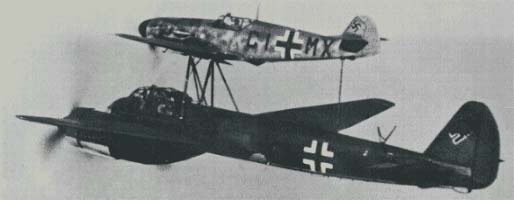
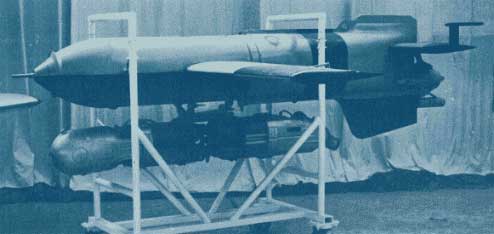

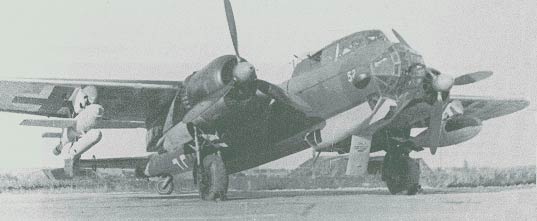
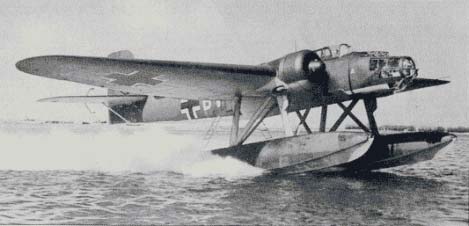
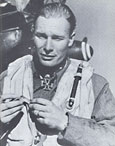

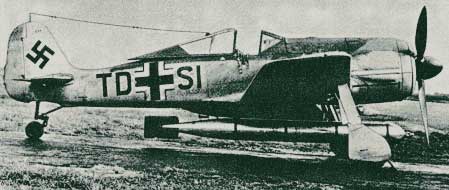
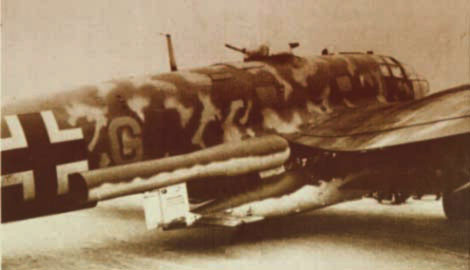
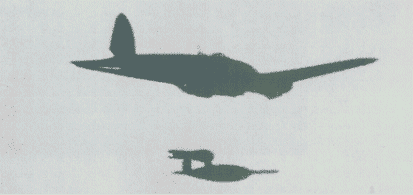
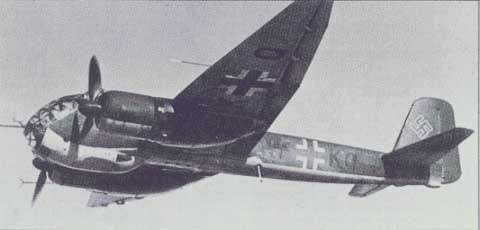
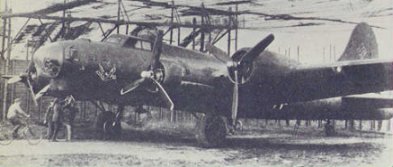


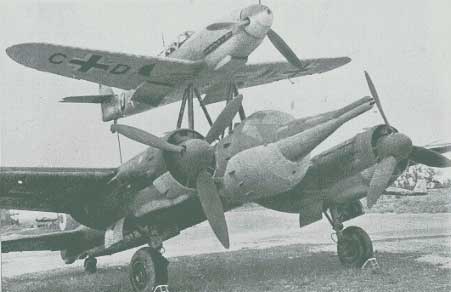
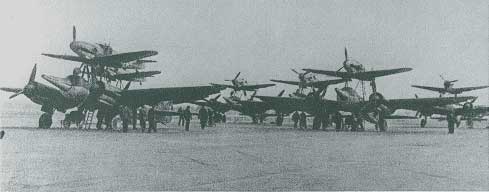
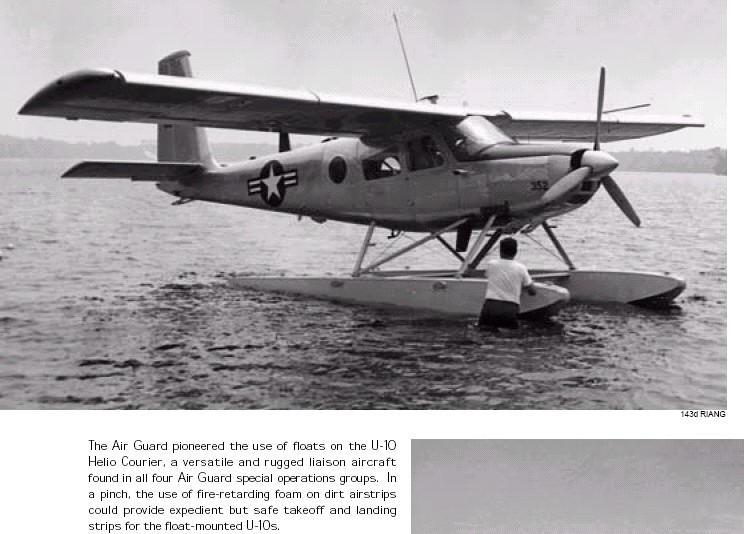

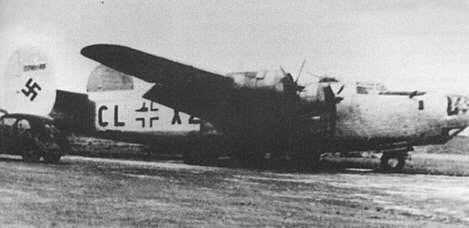
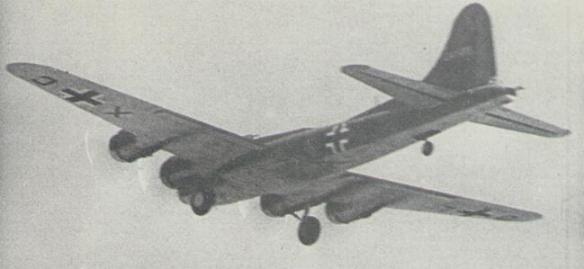
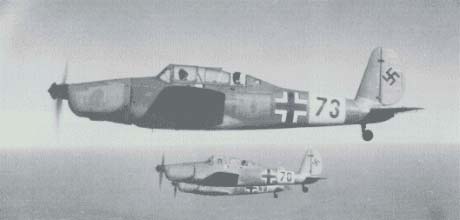
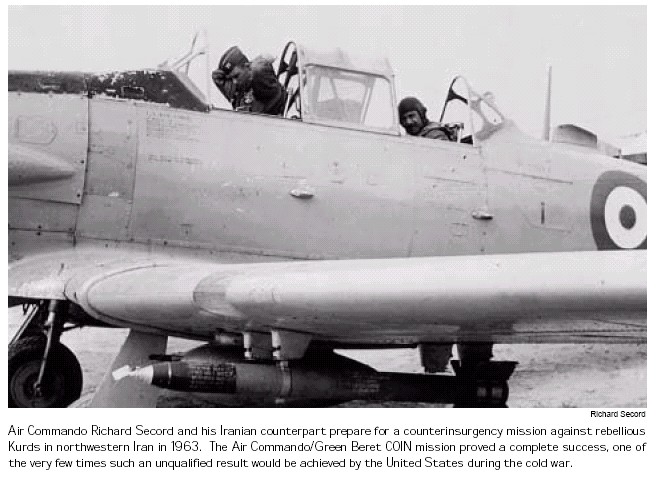
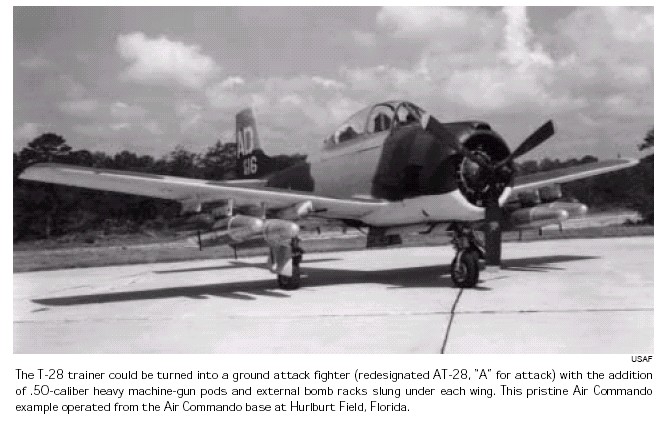
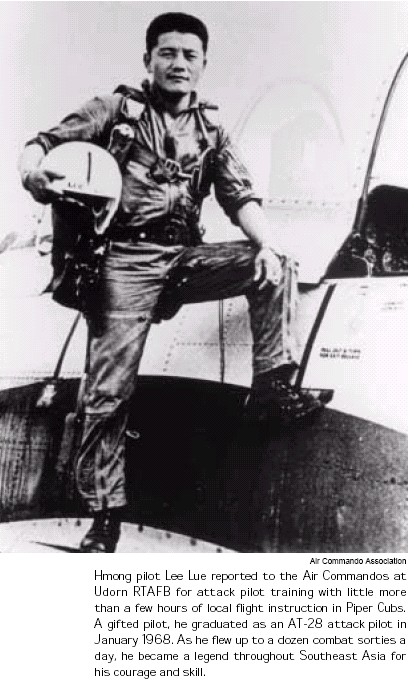
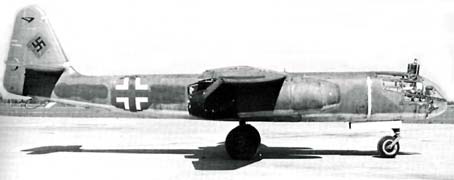
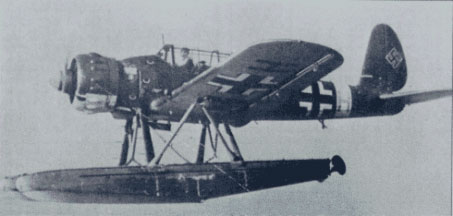


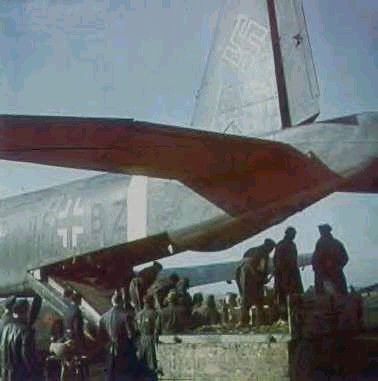
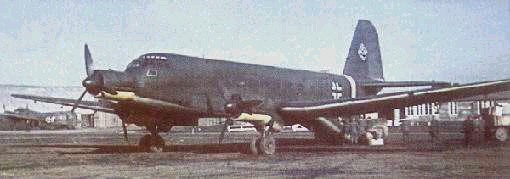
Only 45 examples of the Junkers Ju-352 "Hercules" were built, KG 200 got most of them! The Ju-352 was powered by three 1000 HP Bramo radials and had an hydraulic rear ramp (called "trapoklappe") that raised the aircraft nearly horizontal (see below) for easy loading and unloading of equipment. It's range was 1,102 miles at a maximum speed of 230 mph with full load, quite a drop from the impressive Ju-252. (After the war, a captured Ju-352 served as Stalin's personal aircraft!).
User: 6/KG200 (part of II/KG200)
II/KG200 took over all Mistel operations in late 1944. These bomb-laden bombers were released close to the target and radio-guided the rest of the way by the pilot in the fighter. Needless to say these missions were very dangerous, burst tires on take off were common, not to mention the great loss of maneuverability encountered by this "pick-a-back" scheme. The warhead was armed with an 8,377 pound hollow charge which could penetrate 25 feet of steel or 60 feet of reinforced concrete!
Mistels were to be used for "Operation IRON HAMMER". The destruction of the Soviet's electrical generating stations, these were really their Achilles' heel! The central grid near Moscow supplied the power to 75% of their armament industry! The Germans were trying to knock out an entire network of factories in one swift blow. Then, the Red Army having spent most of it's equipment would be pushed back by fresh SS divisions and a separate peace could be negotiated with the Western Allies to carry on the fight against Bolshevism. But the force was caught on the ground at Rechlin air base by raiders of the U.S. 8th Air Force who destroyed 18 of them. With the main strike force destroyed, IRON HAMMER was cancelled. Attacks by flights of 2 to 4 Mistels went on until the end of the war against key pinpoint targets such as bridges.
Users: 1/KG200 and 2/KG200 (both part of I/KG200)
The Henschel Hs-293 rocket-driven remotely-controlled missile. Originally an anti-shipping stand-off weapon, it soon proved it's worth against a multitude of targets. The weapon was radio controlled to the target by the bomb aimer of the mother aircraft, it was first used successfully against British destroyers in the Bay of Biscay by Do-217s of II/KG100. On March 1, 1945, Hitler personally appointed Oberst Baumbach, ex-CO of KG 200 and now "inspector of bombers" to the post of plenipotentiary for preventing an Allied crossing of the Oder and Neisse rivers. On March 6, an Hs-293 launched by a KG200 Do-217 hit the Oder bridge at Goeritz. The same bridge was again attacked 2 days later by II/KG200 with five Mistels escorted by Ju-188 bombers which scattered the air defenses. The Mistels destroyed two bridges.
Suggested Reading
German captured Spitfire fighter
The problem with top secret units is that they're secret, so there isn't that much written or known about them. A problem with German units is that they destroyed many of the documents about the squads. KG200 books are few & far between.
KG200 The True Story
Geheimgeschwader KG 200: die wahrheit nach uber 30 Jahren
KG 200
The Life and Death of the Luftwaffe
B-17 Fortress at war B-24 Liberator in action
Flying Fortress
A-26K Counter-Invader: Best Enemy Truck Killer in Vietnam: Hated by the Fighter Jock USAF Brass because it Works!
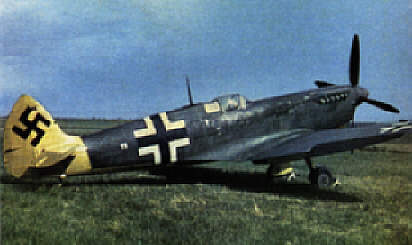
P.W. Stahl
Published 1981 by Book Club Associates, London.
Originally published as:
Published 1979 by Motorbuch Verlag, Stuttgart
(A novel)
J.D. Gilman & John Clive
Published 1977 by Souvenir Press Ltd, London 1978 by Pan Books Ltd. ISBN 0-285-62274-9
(No mention of KG200, but the author was Geschwader Kommodore)
Werner Baumbach
Published 1967 Ballantine Books, New York, Library of Congress Catalog Card Number 60-11283
Roger A. Freeman
Published 1977, Library of Congress Catalog Card Number 76-39758
Squadron/Signal publications
Edward Jablonski
Published in 1965 Library of Congress Catalog Card Number 65-19886
